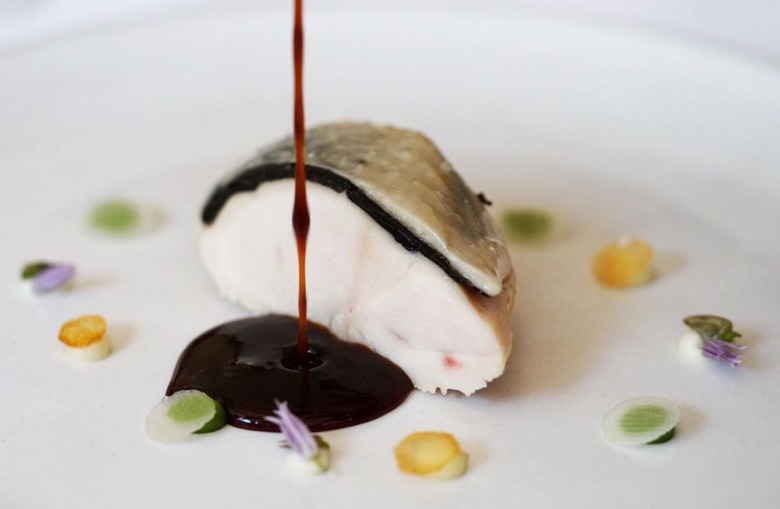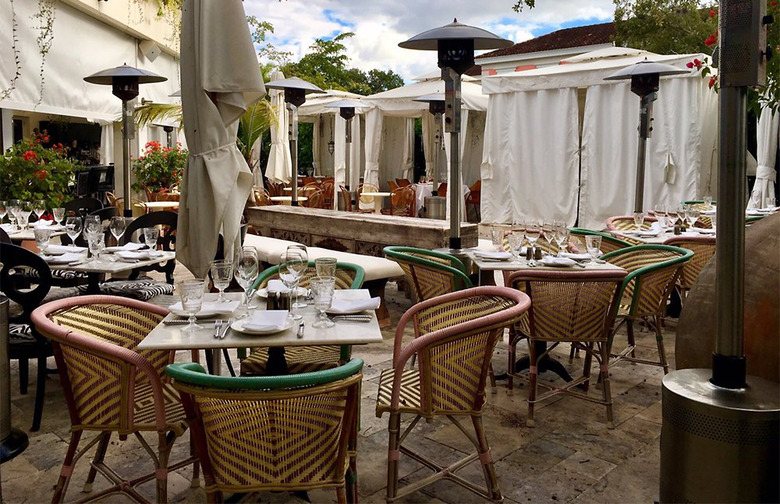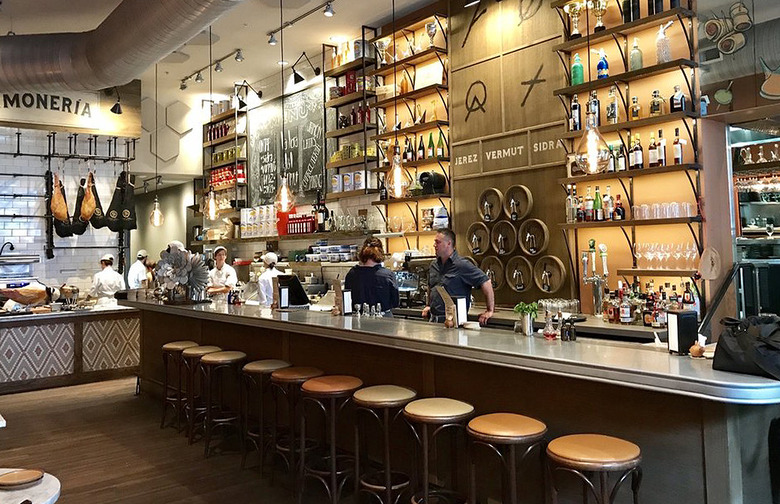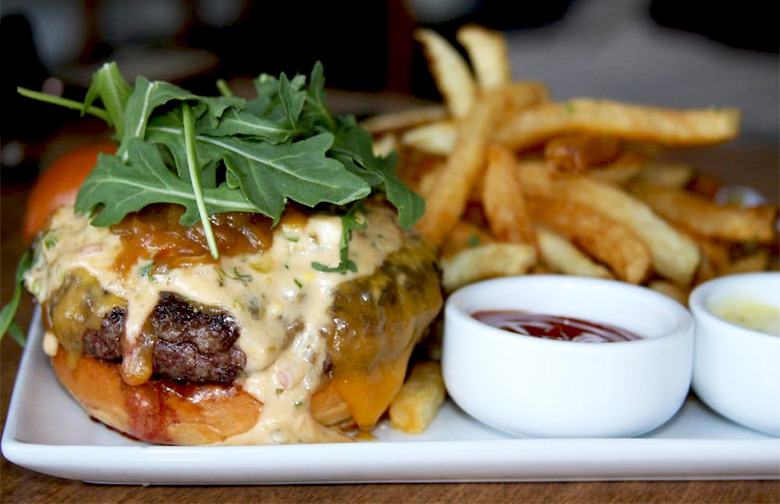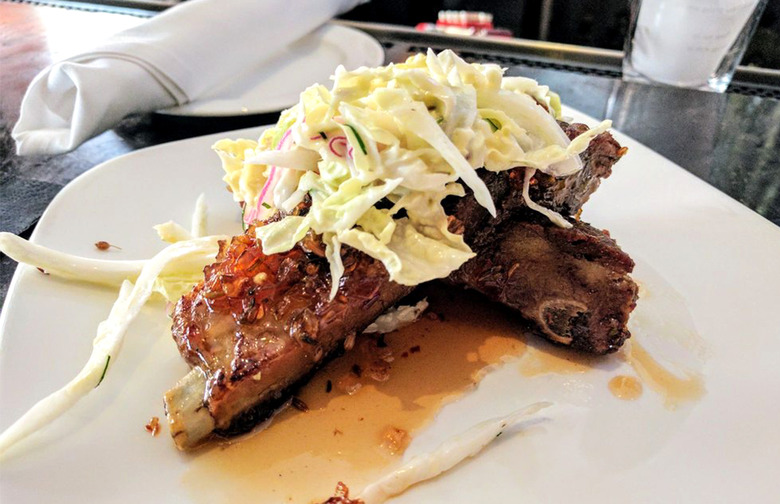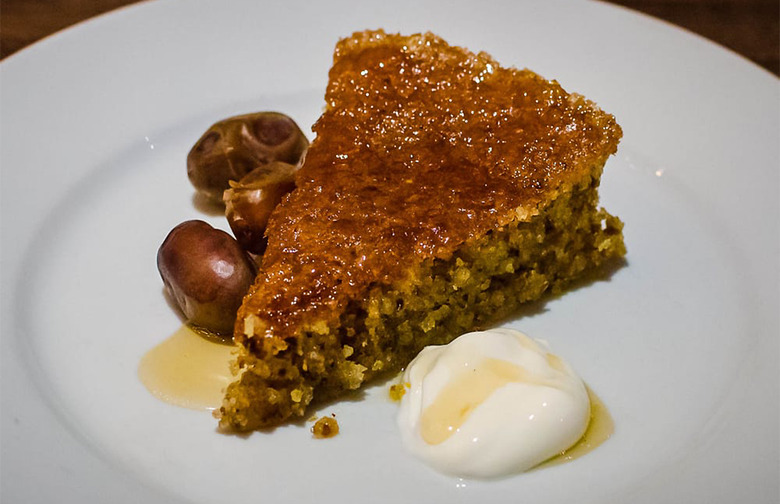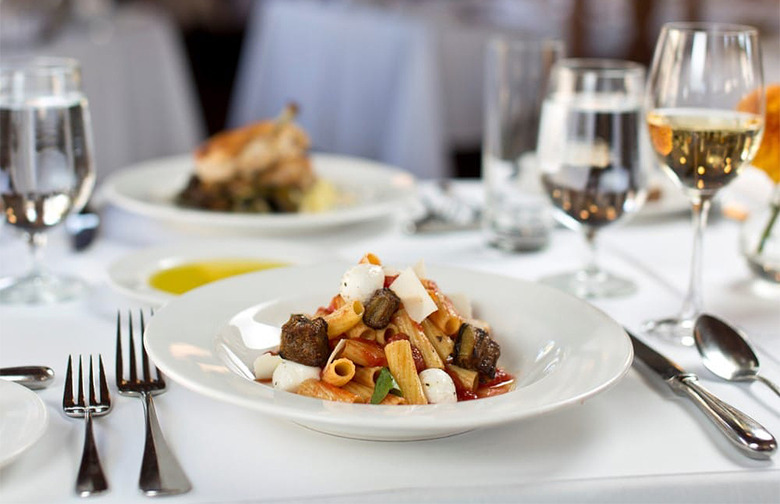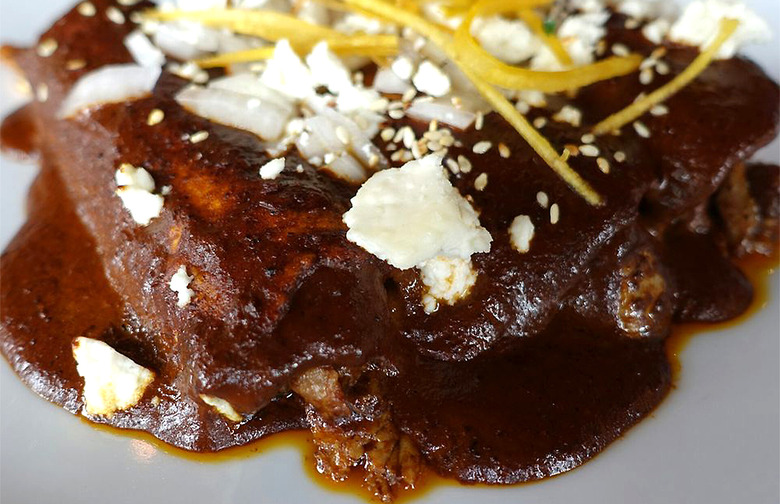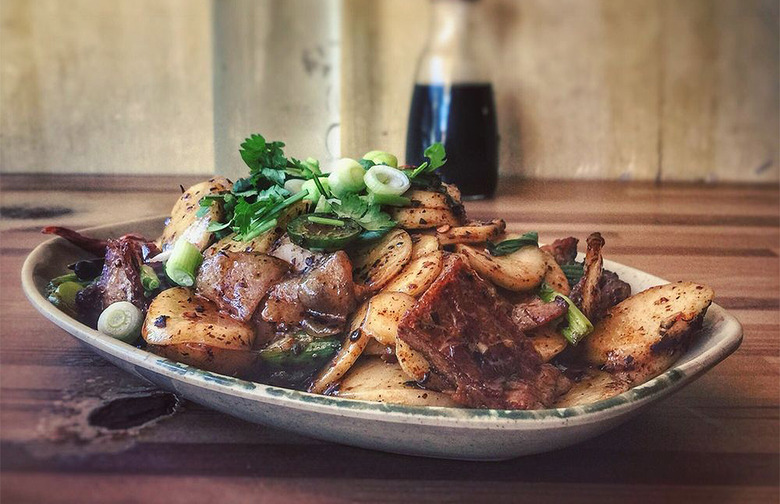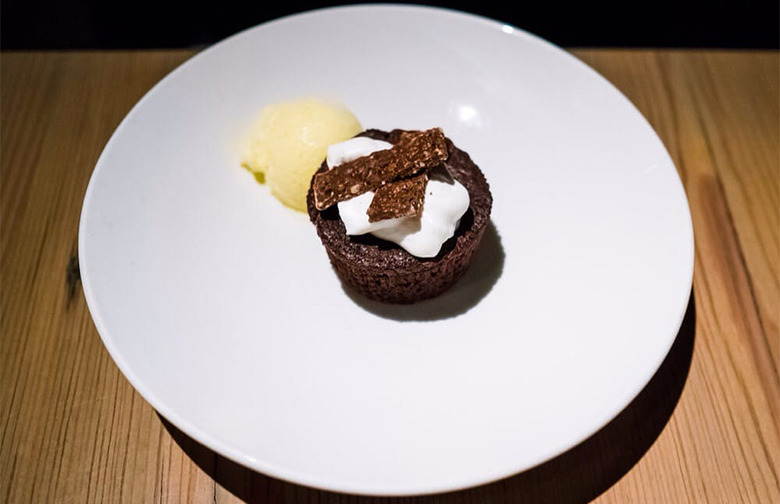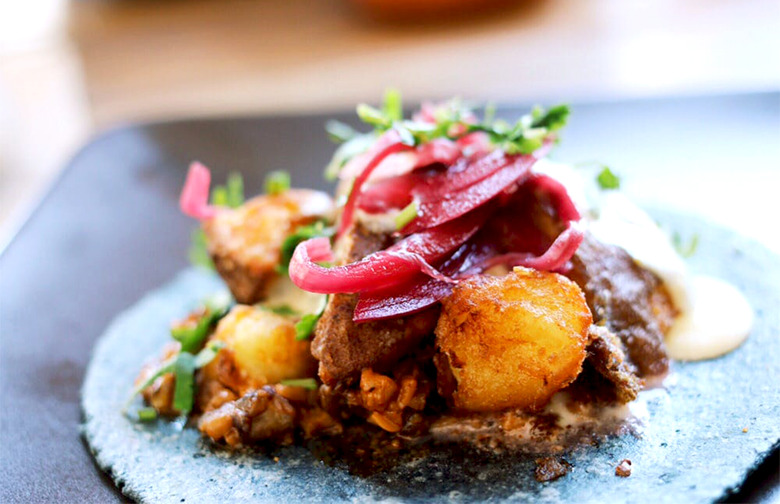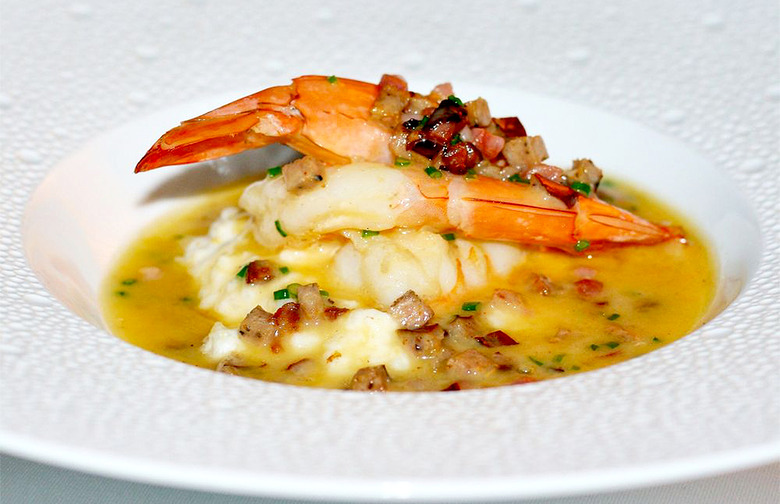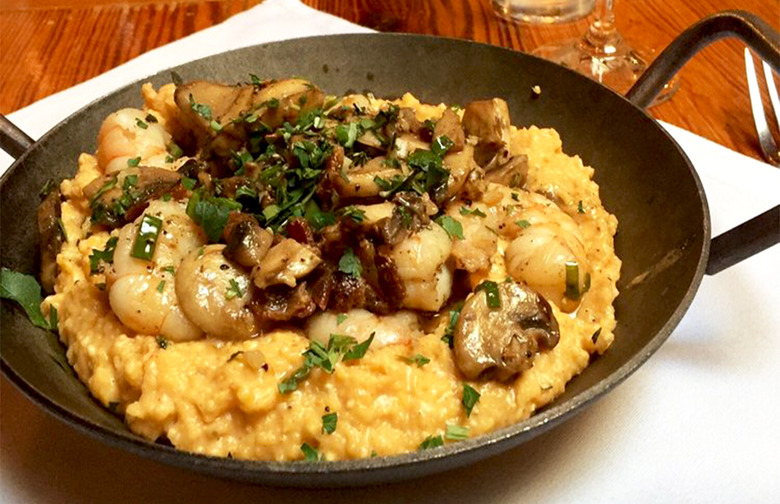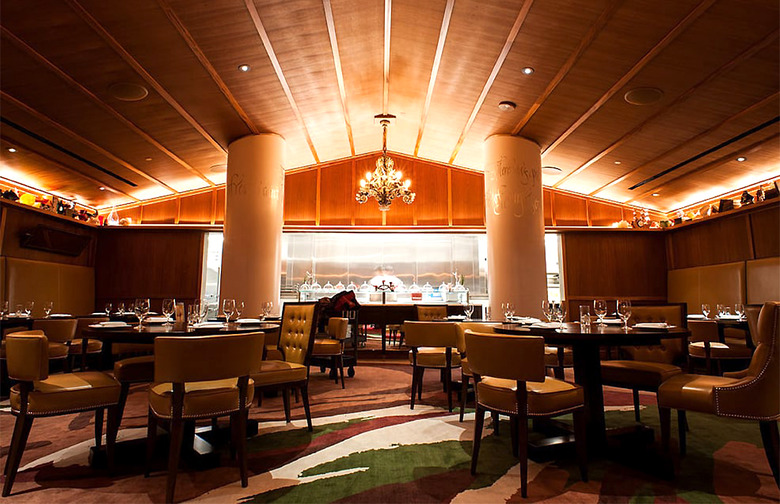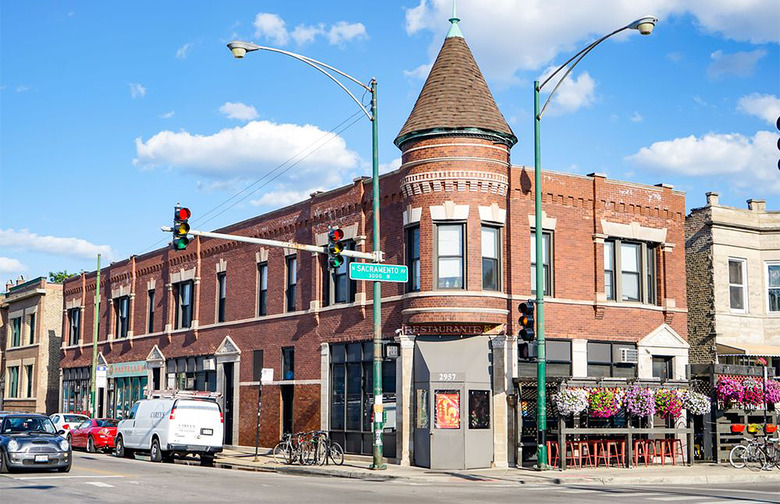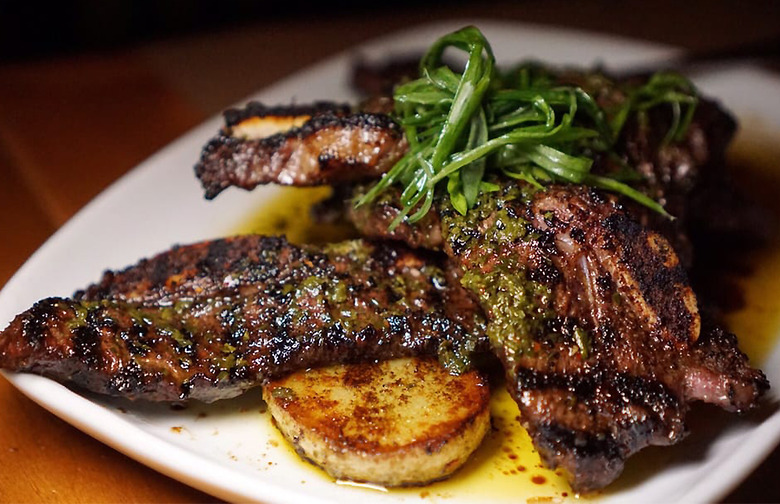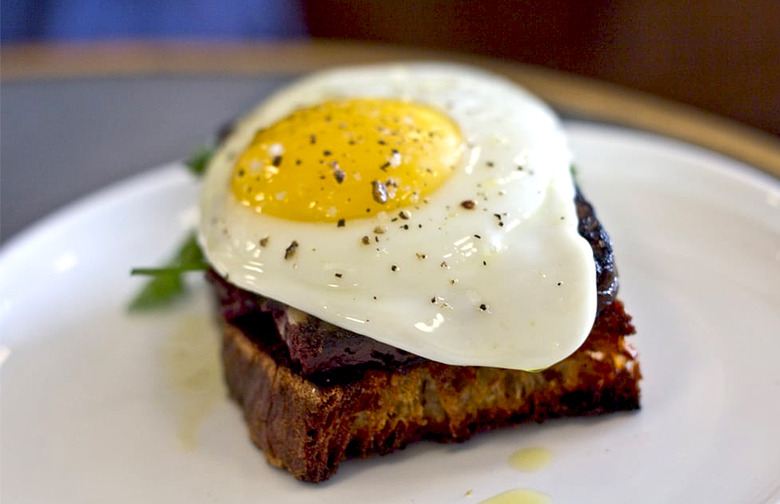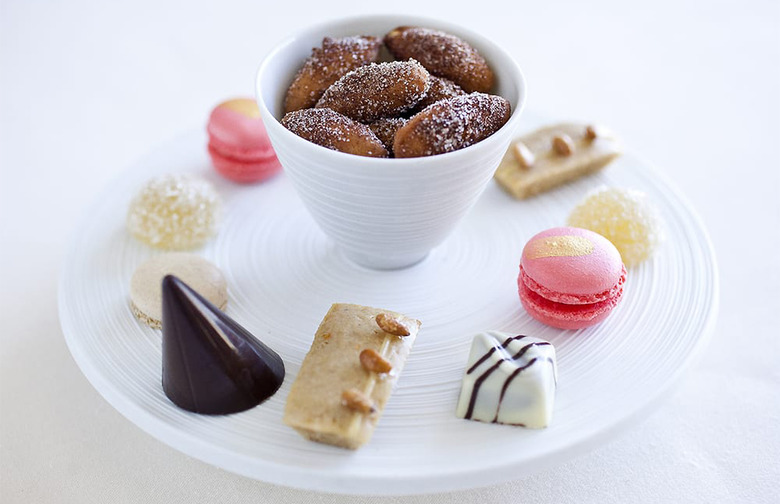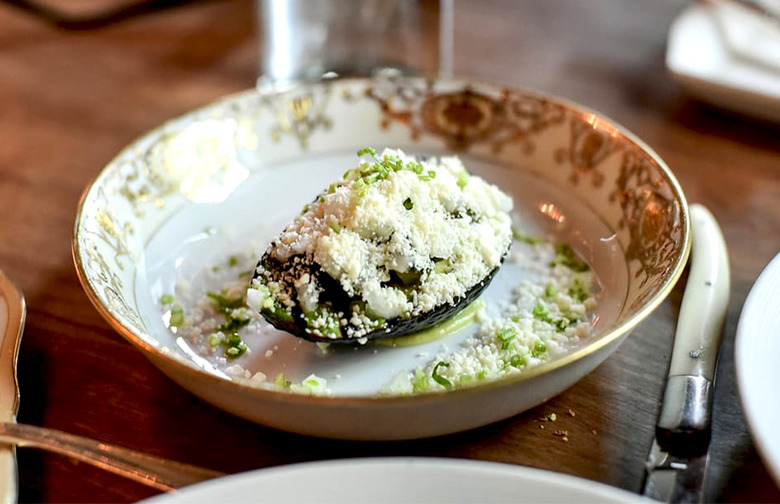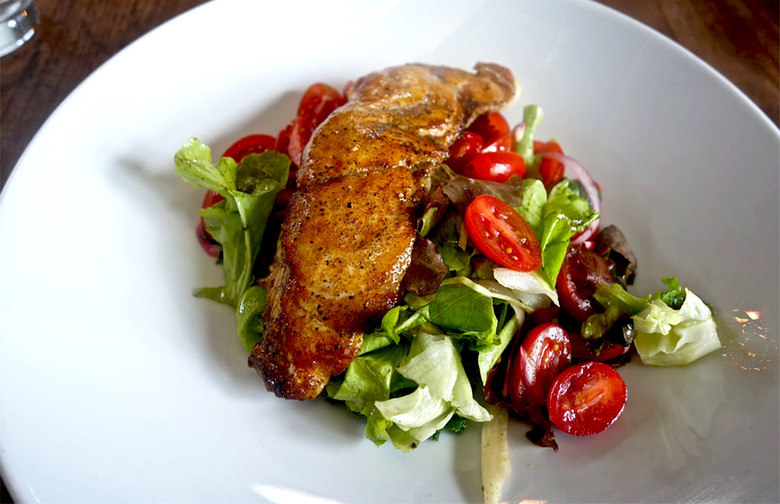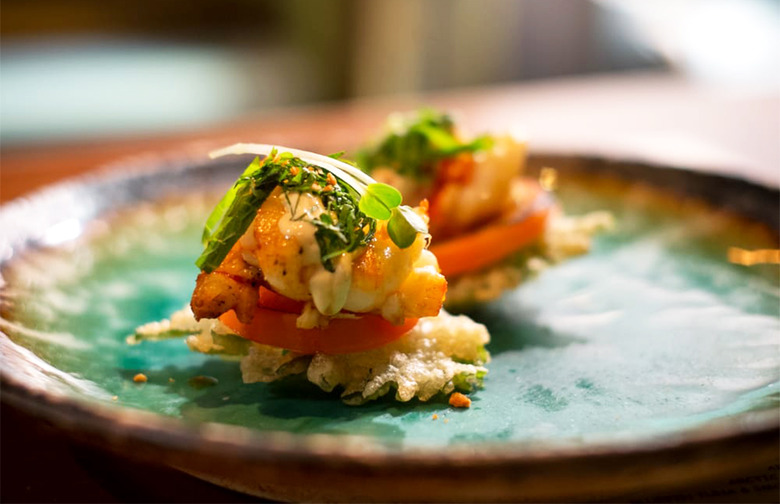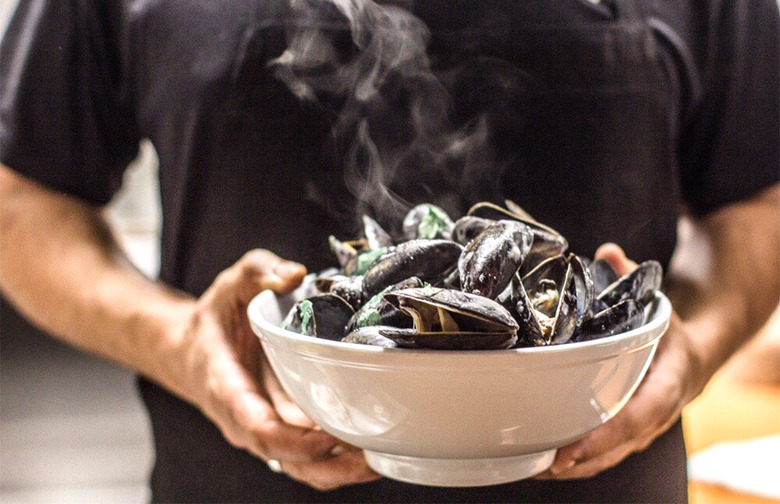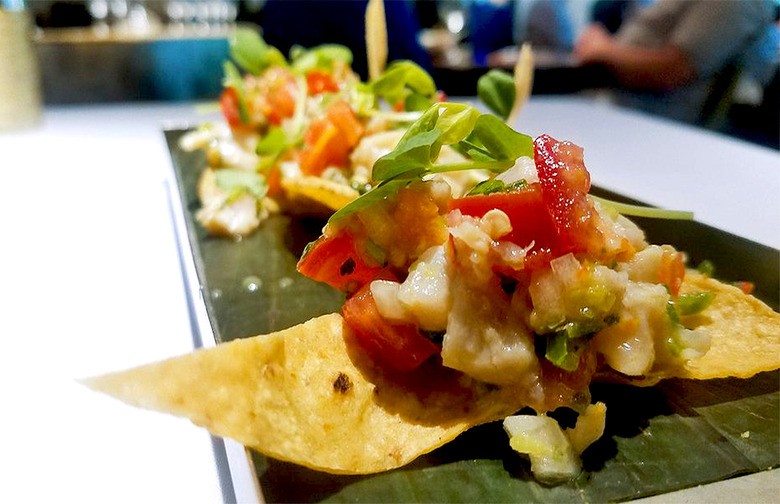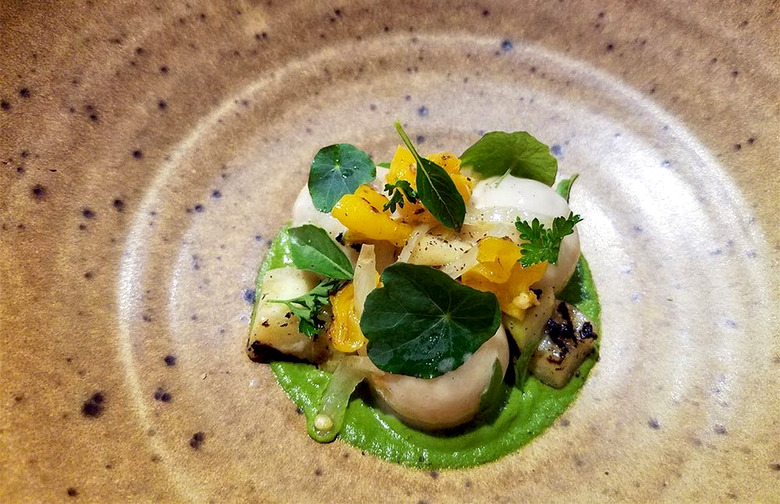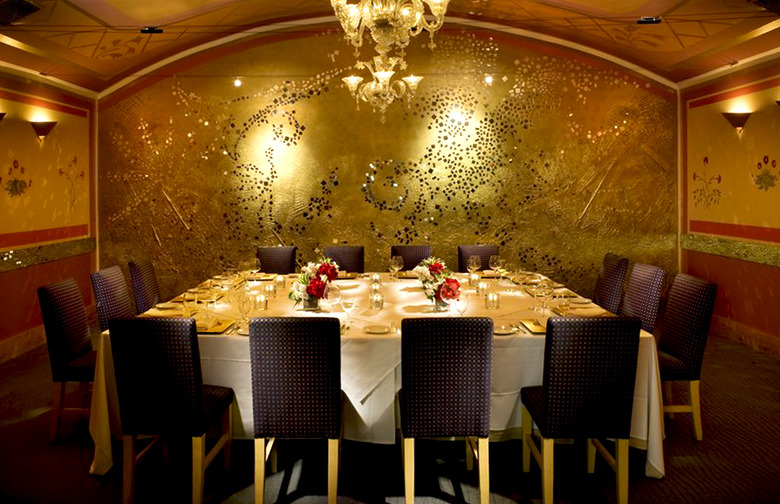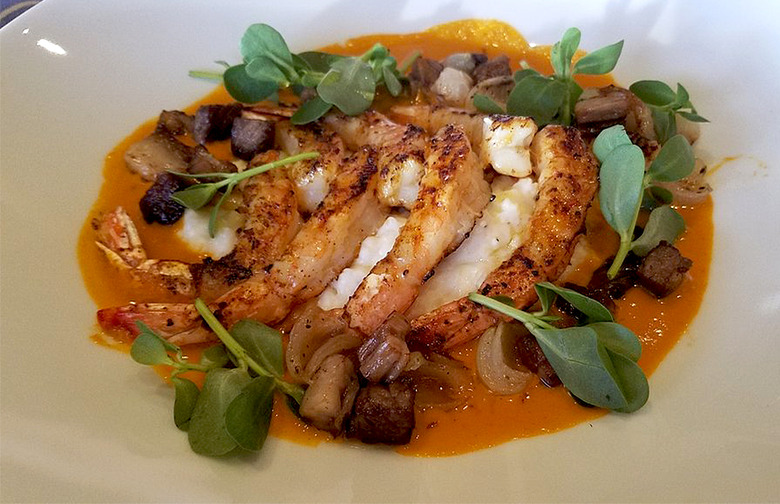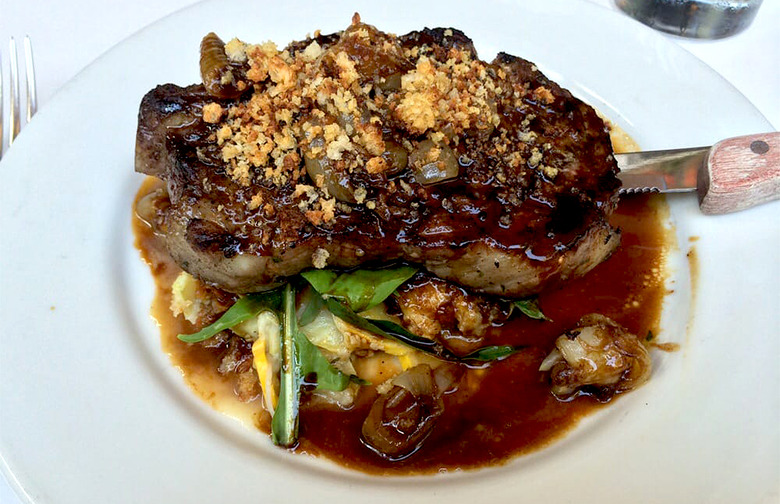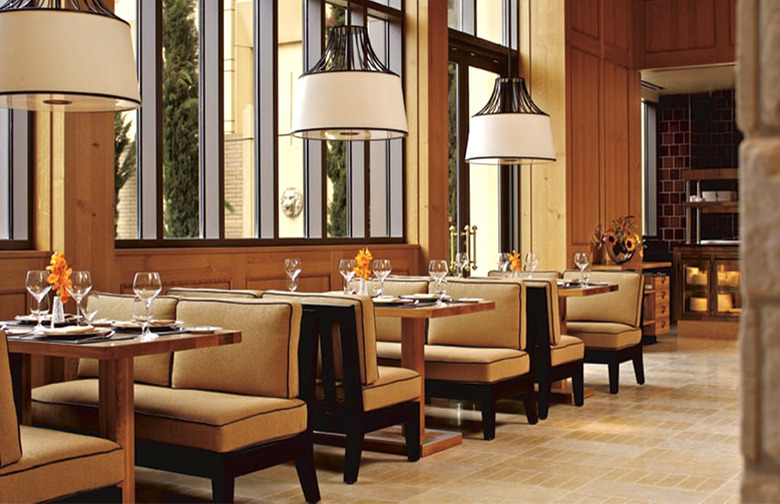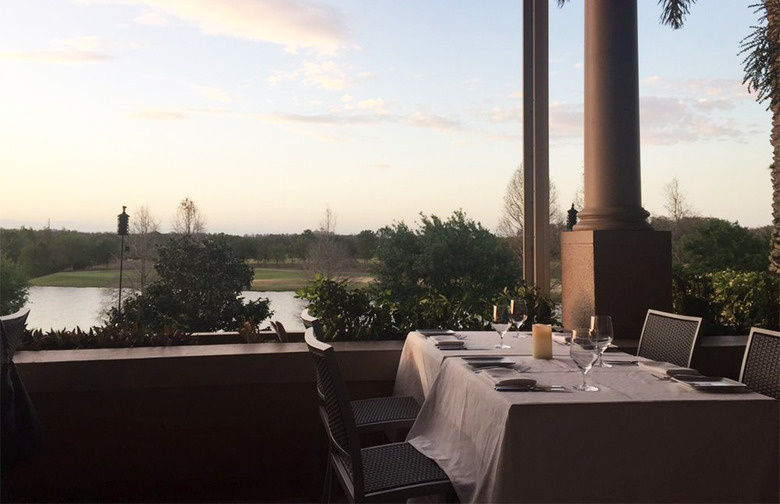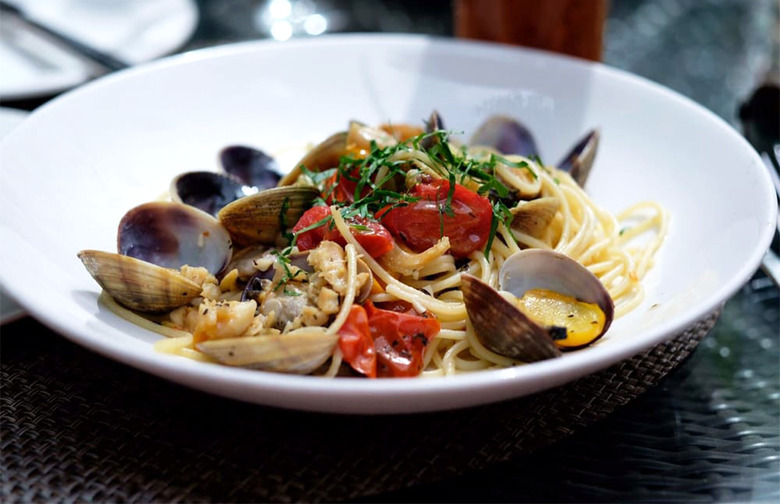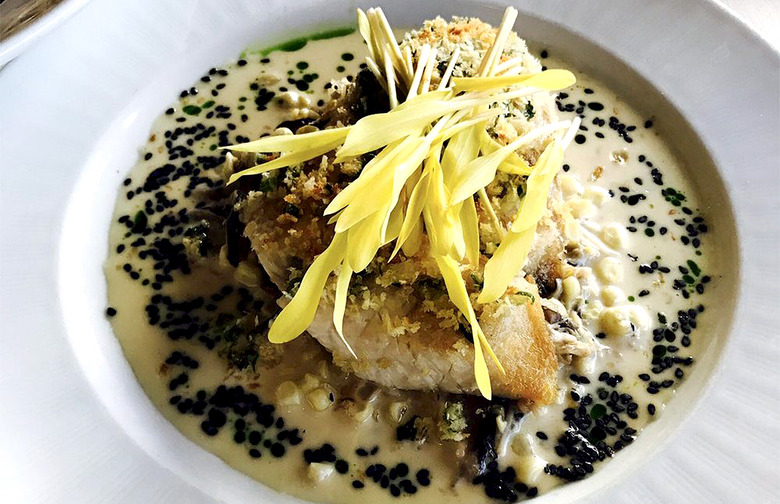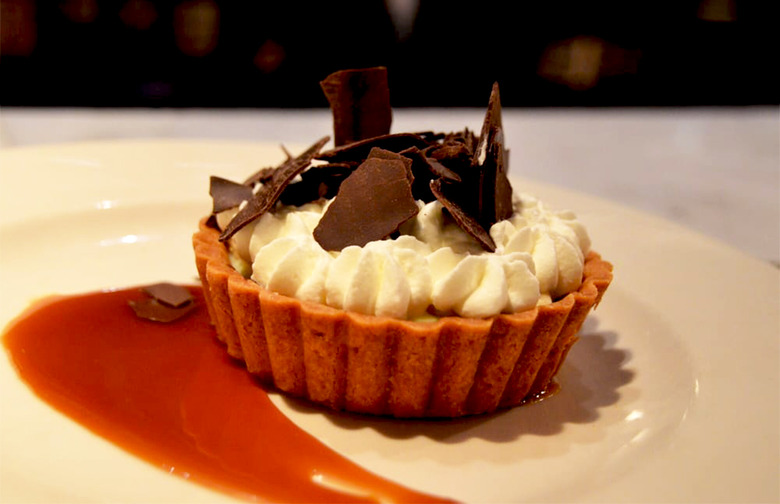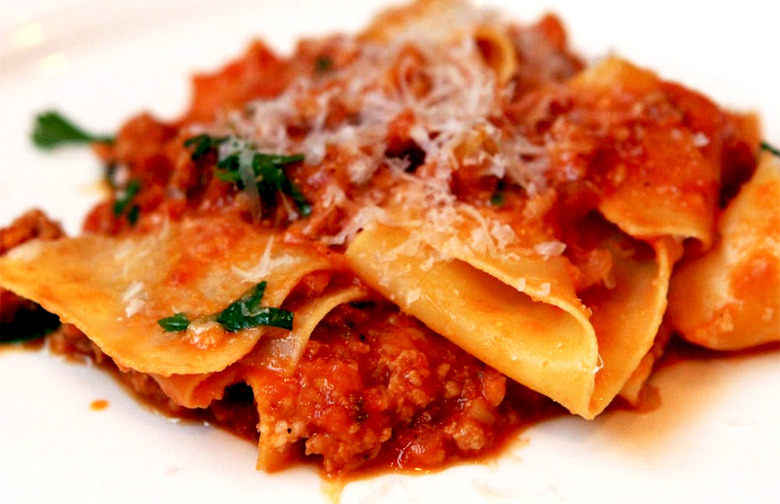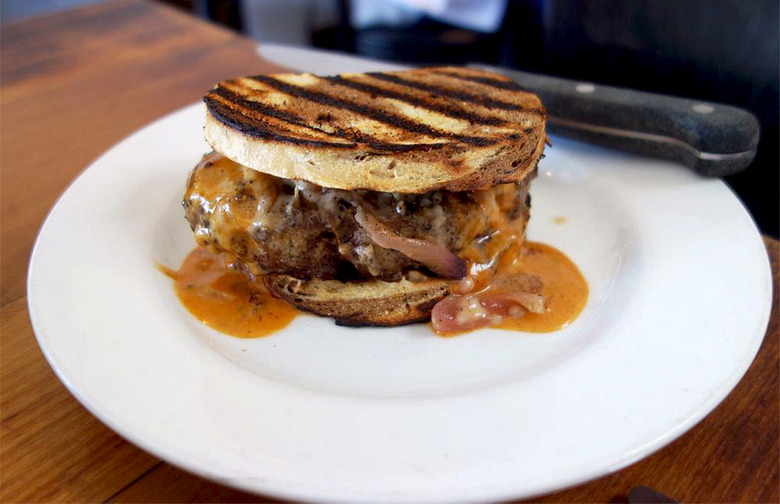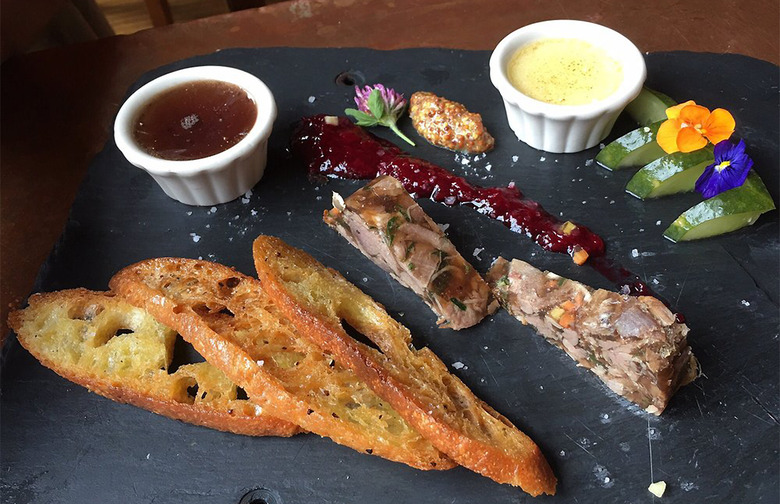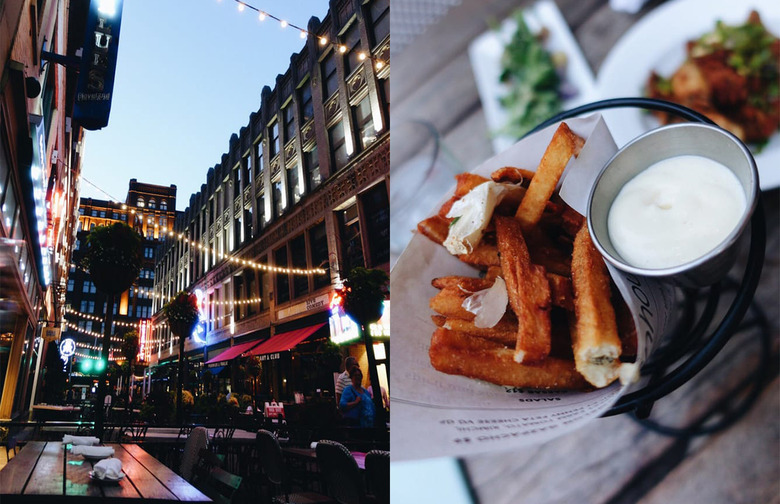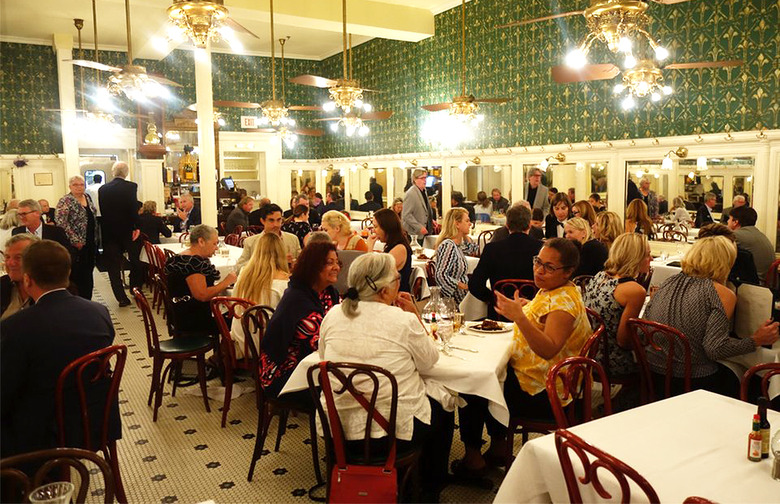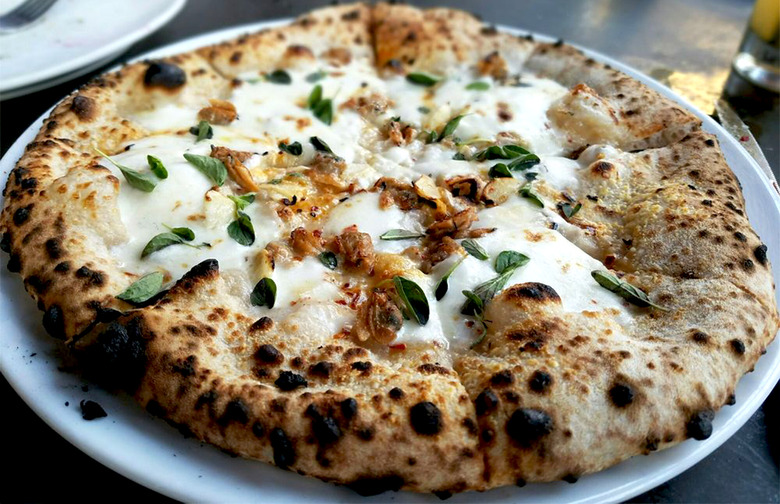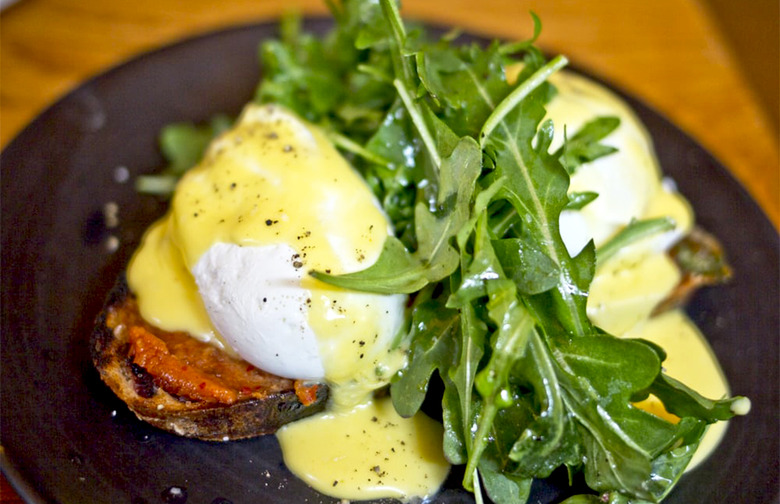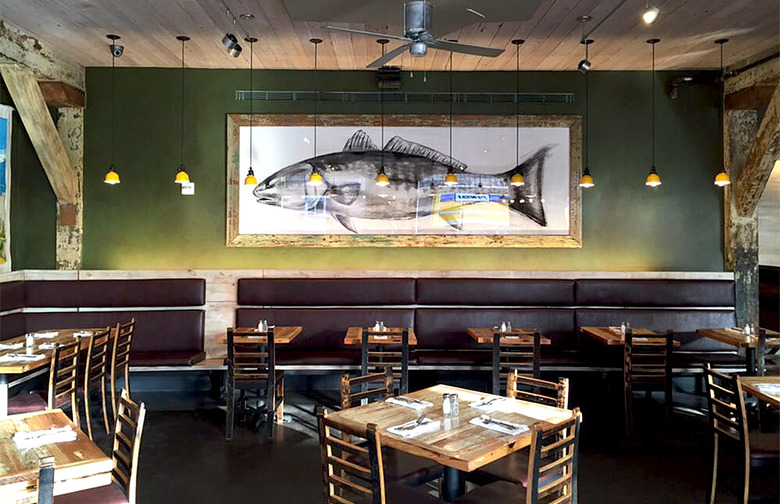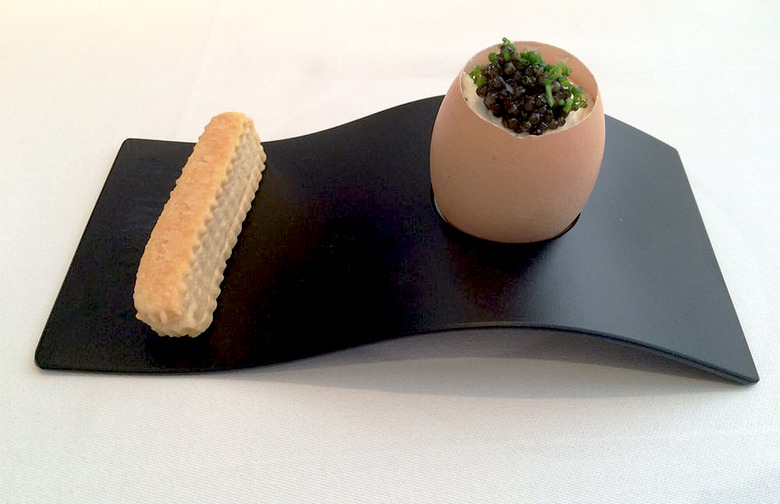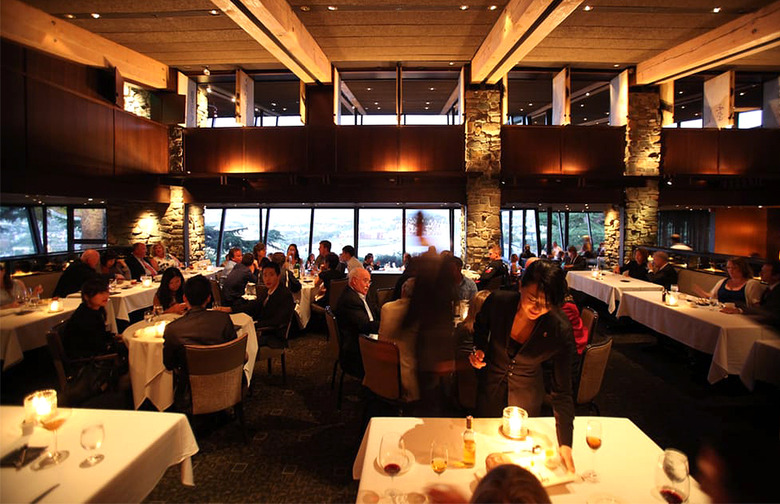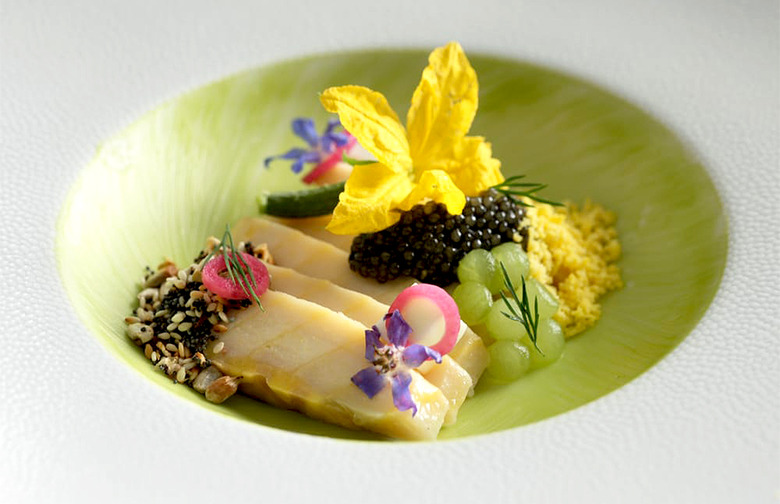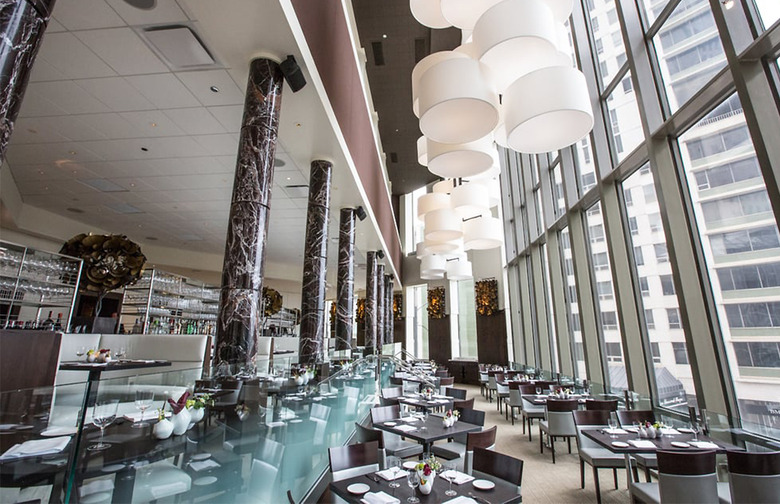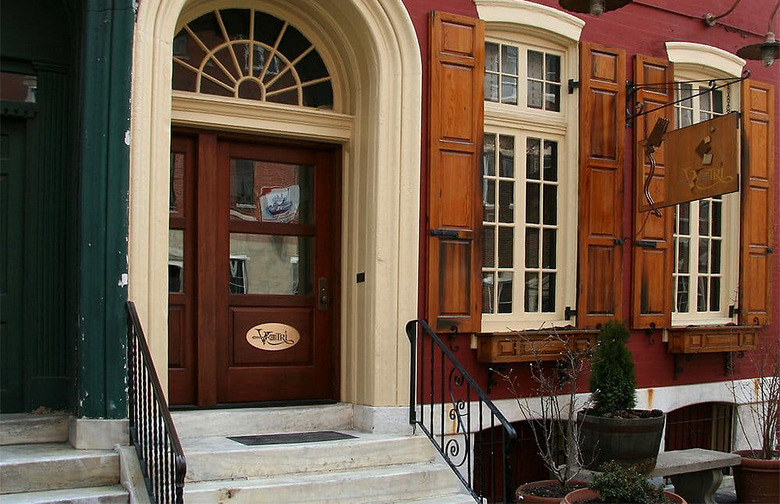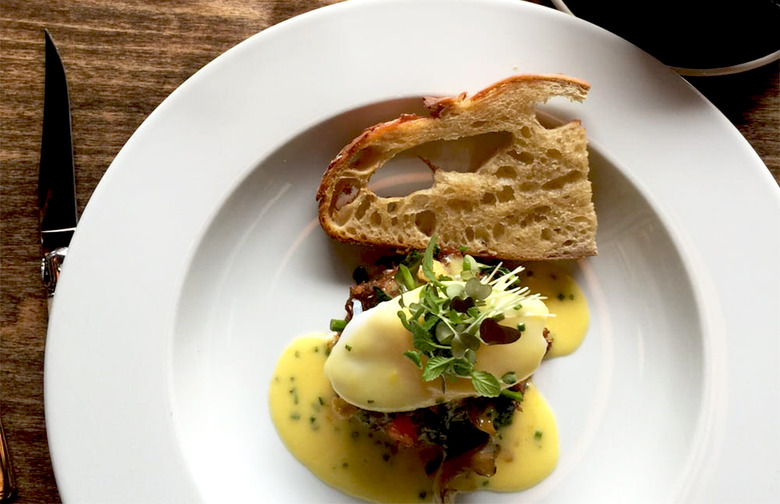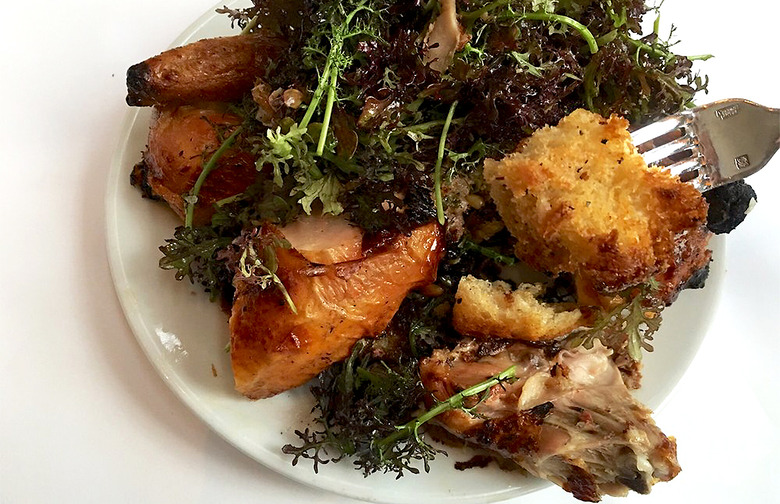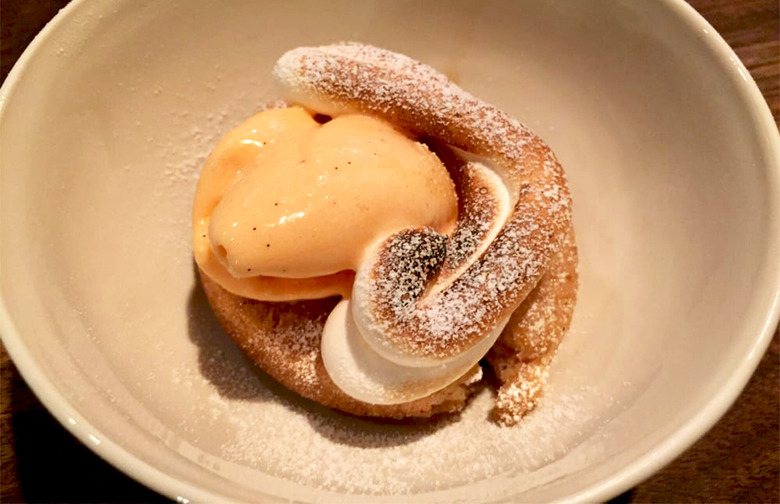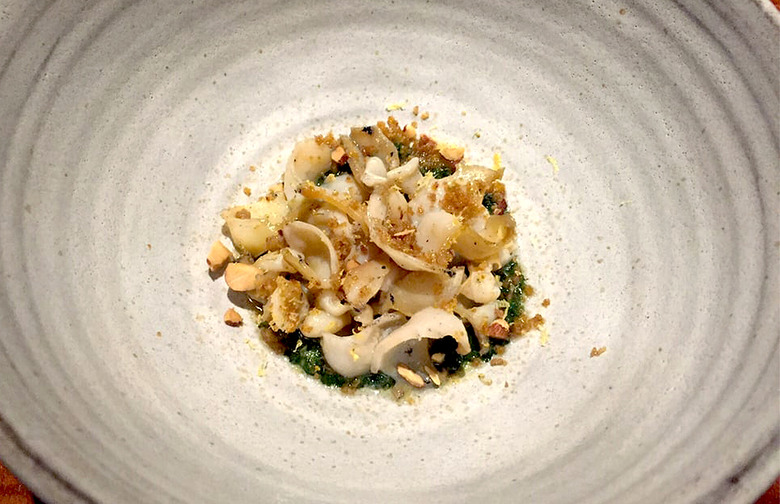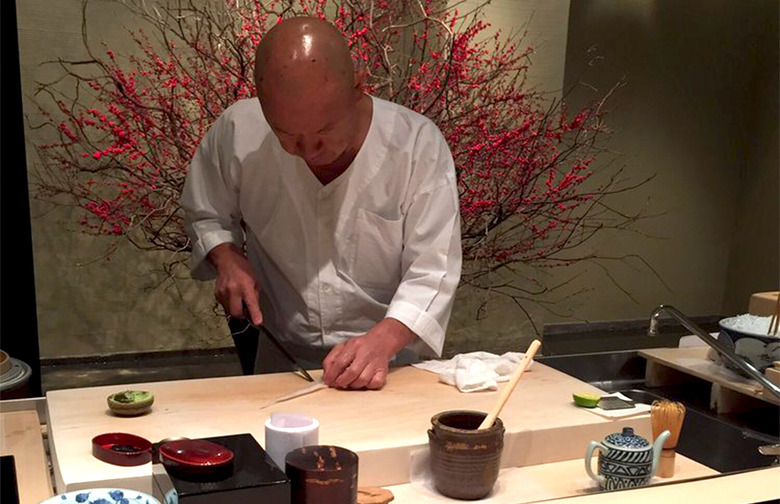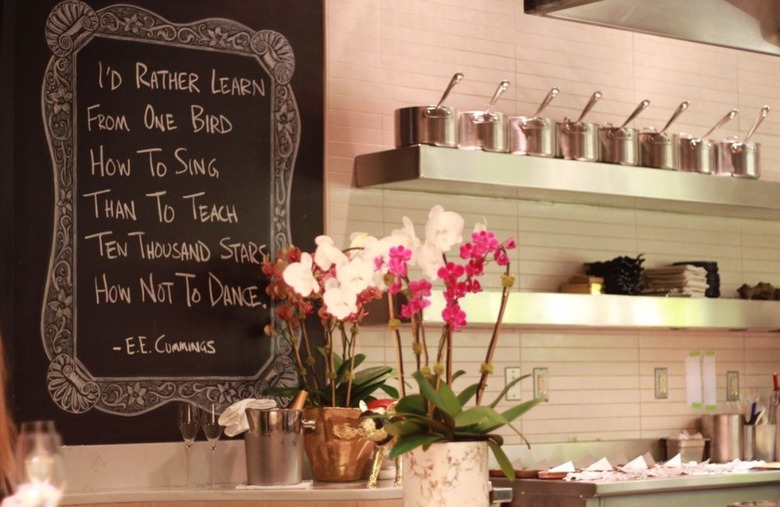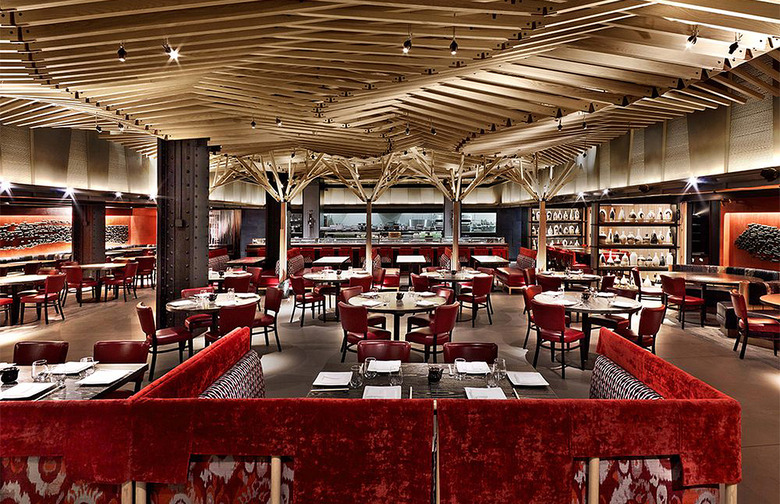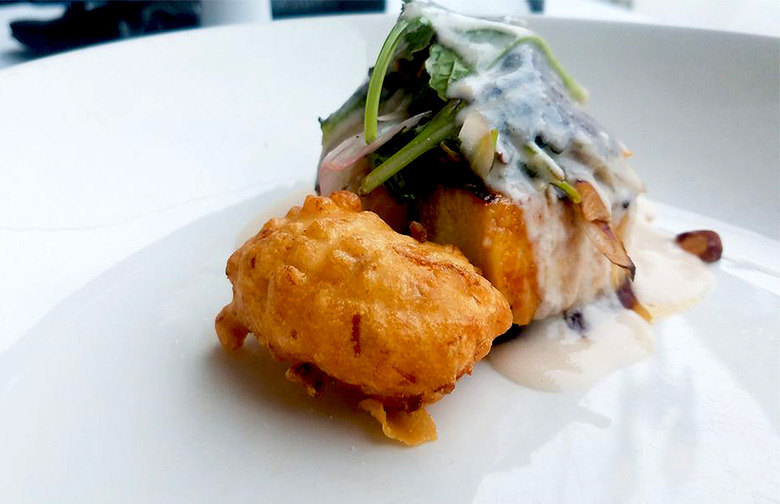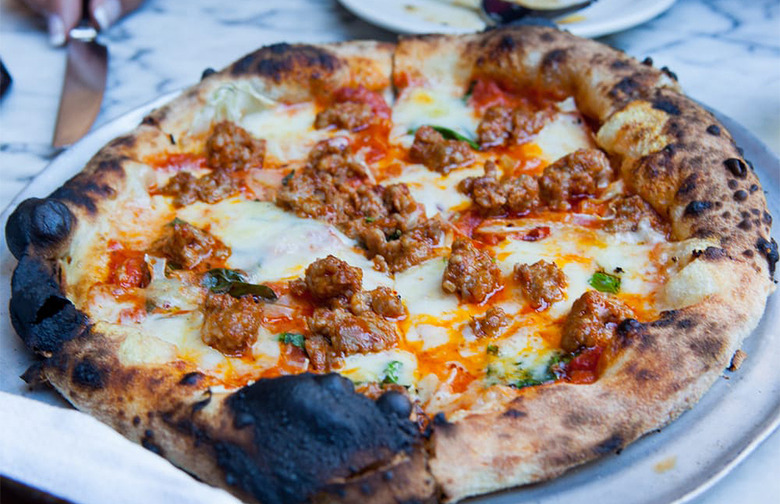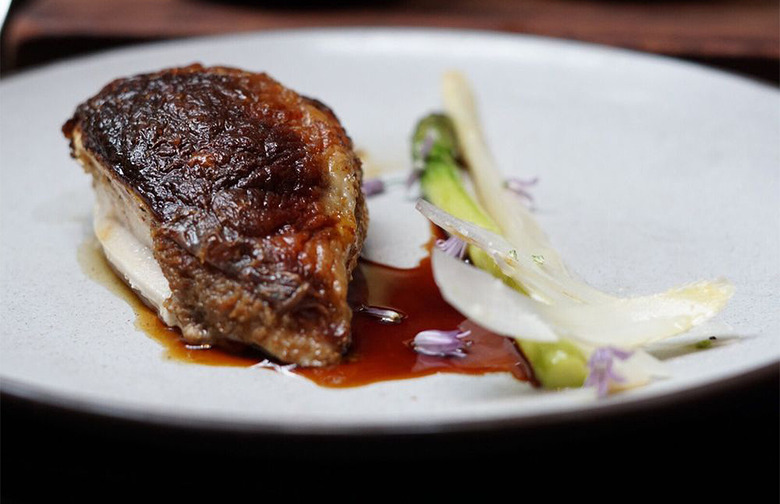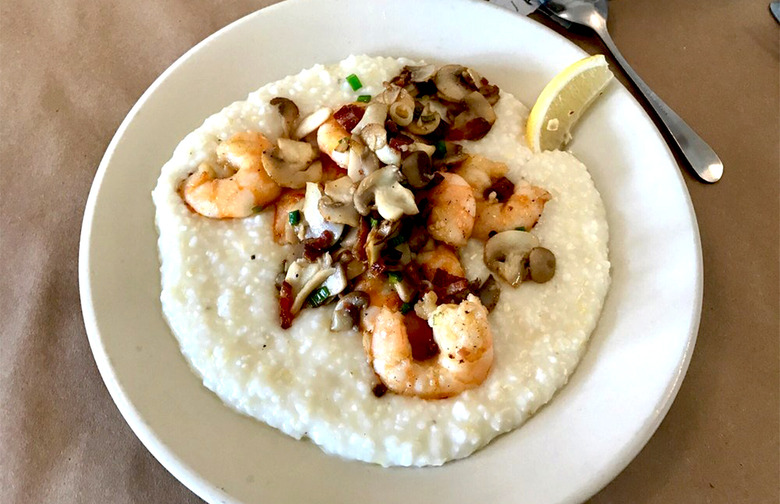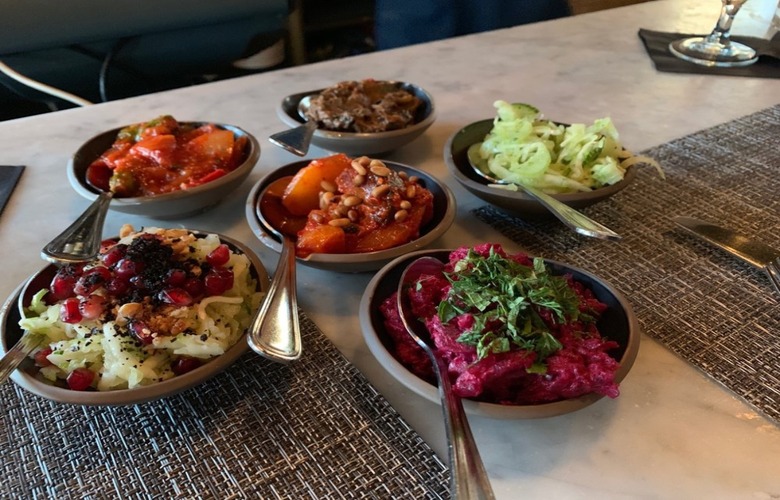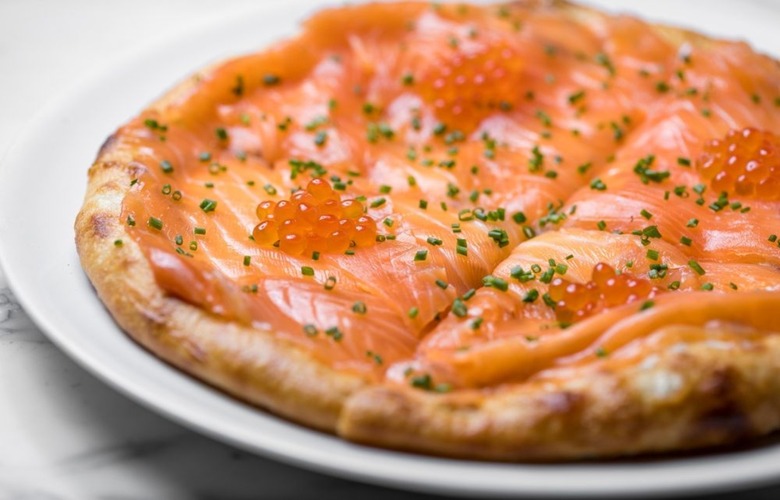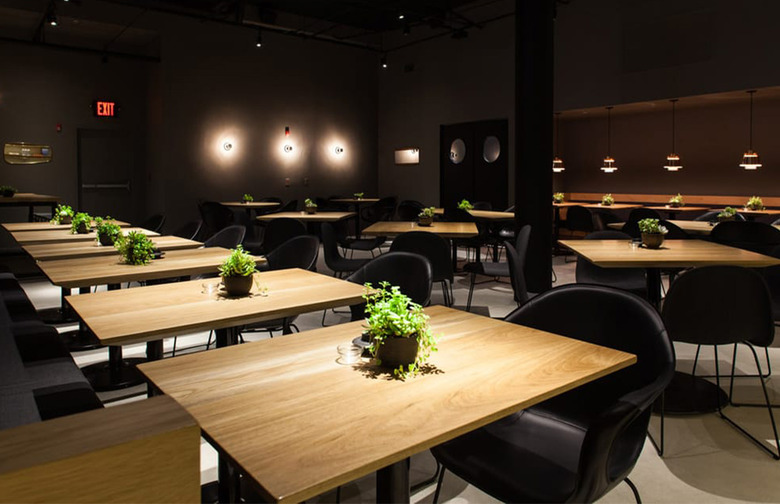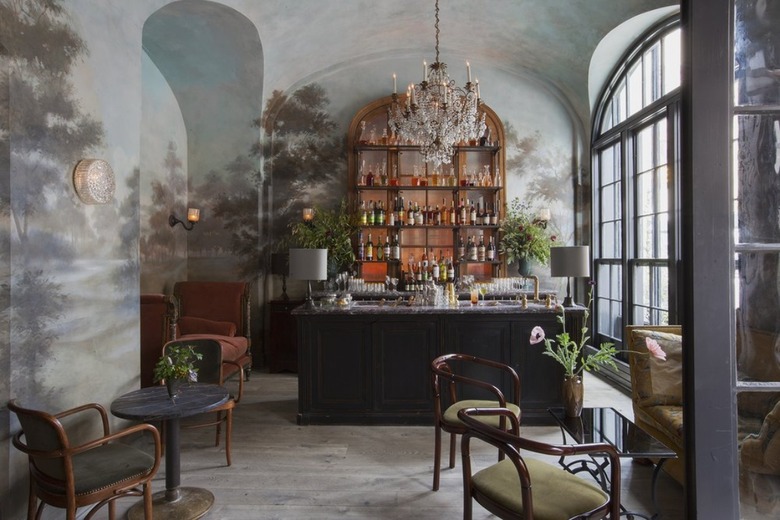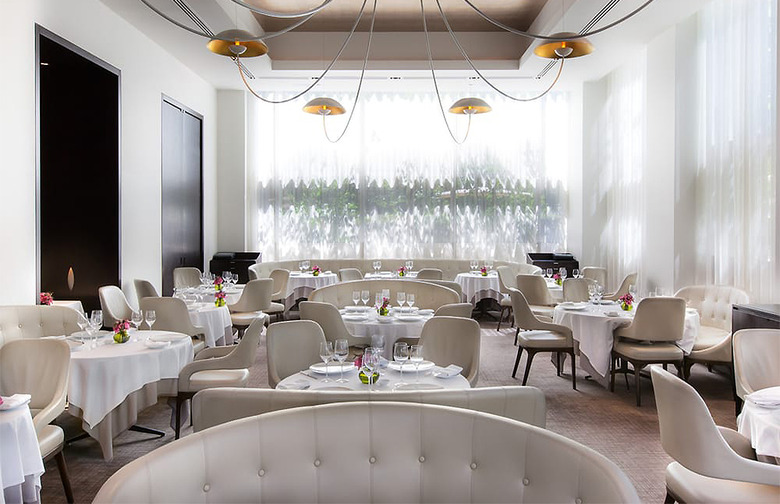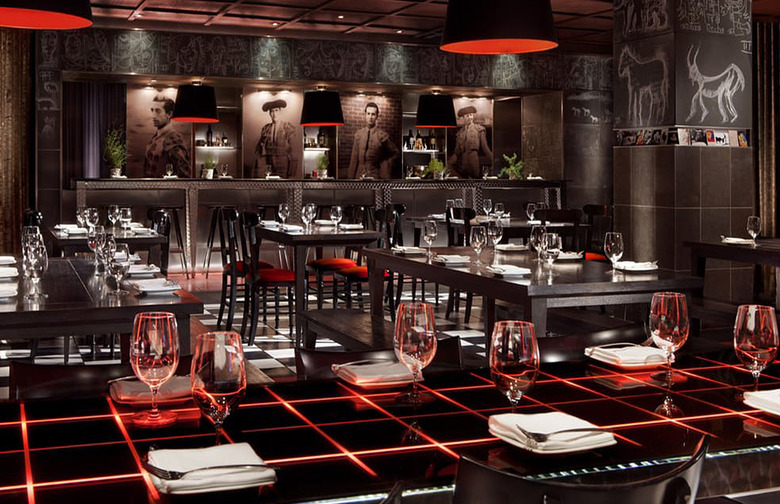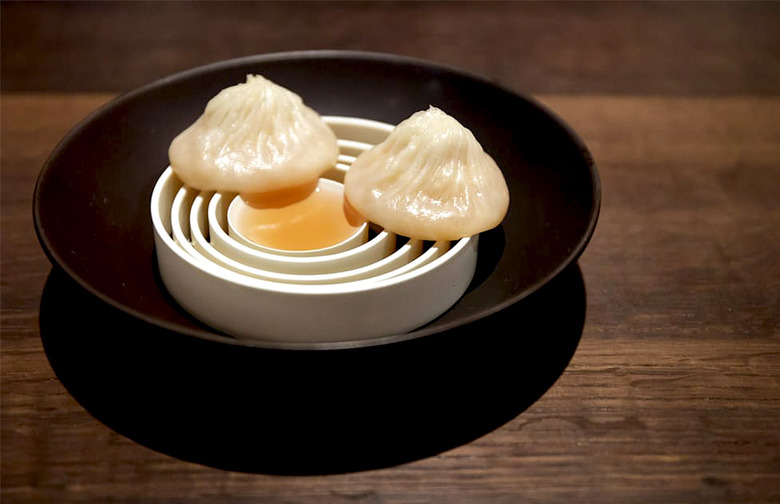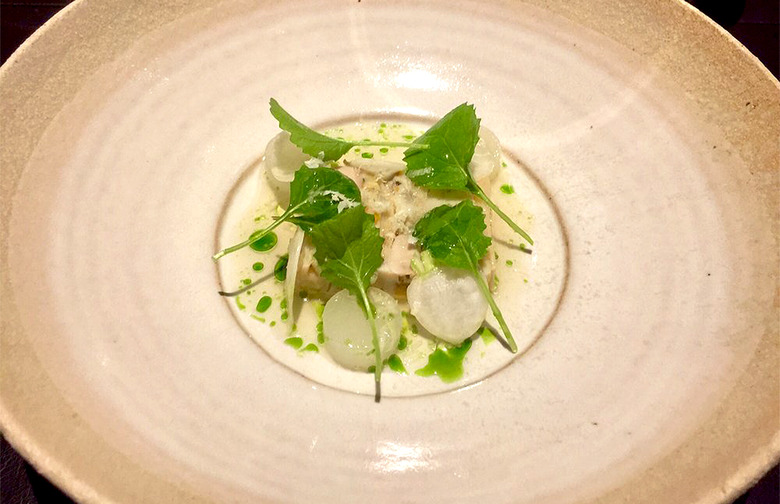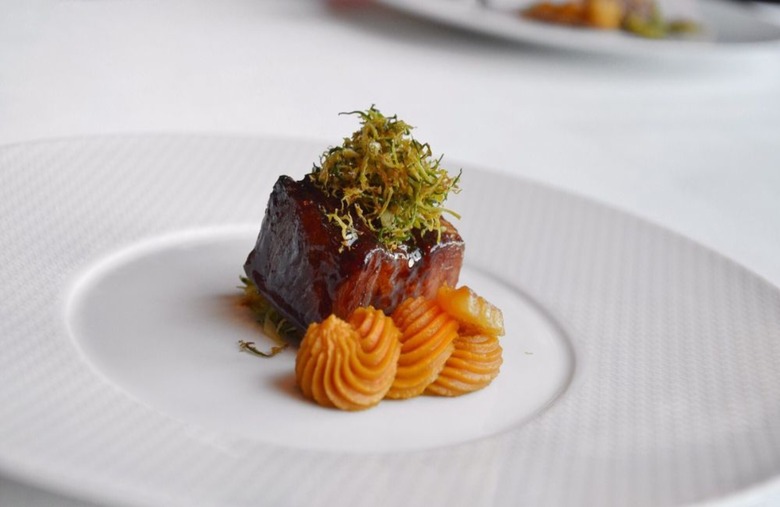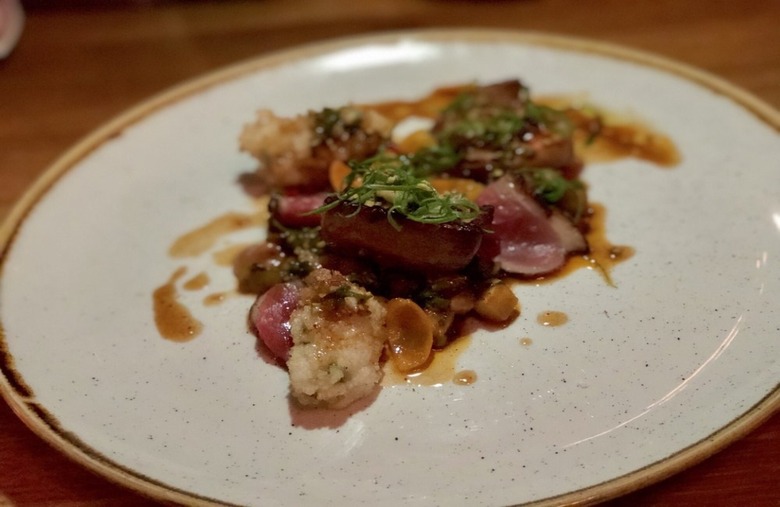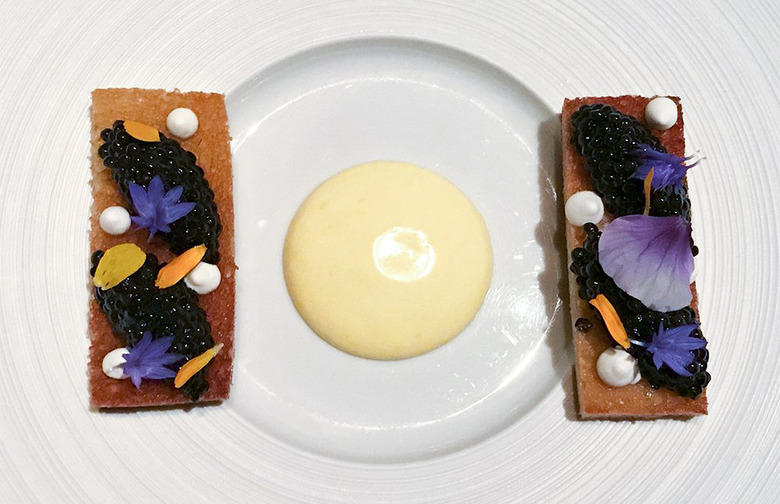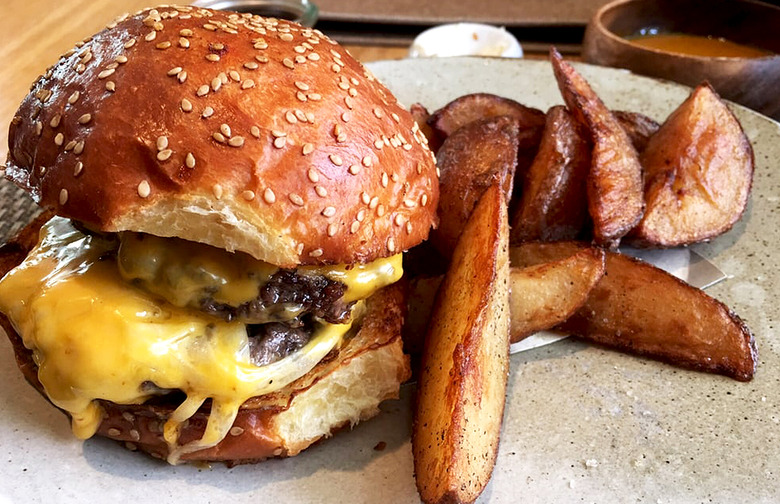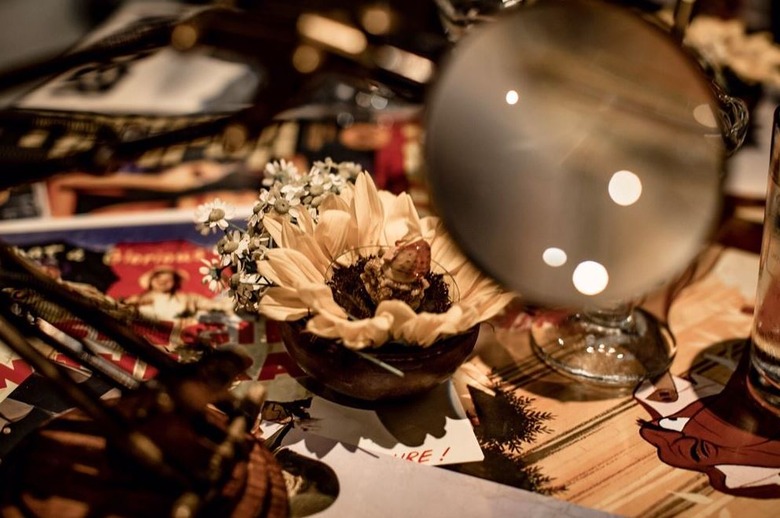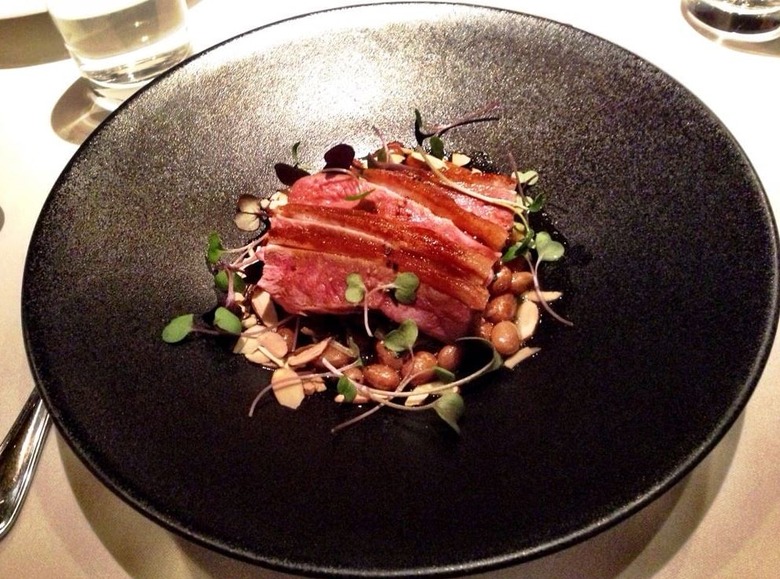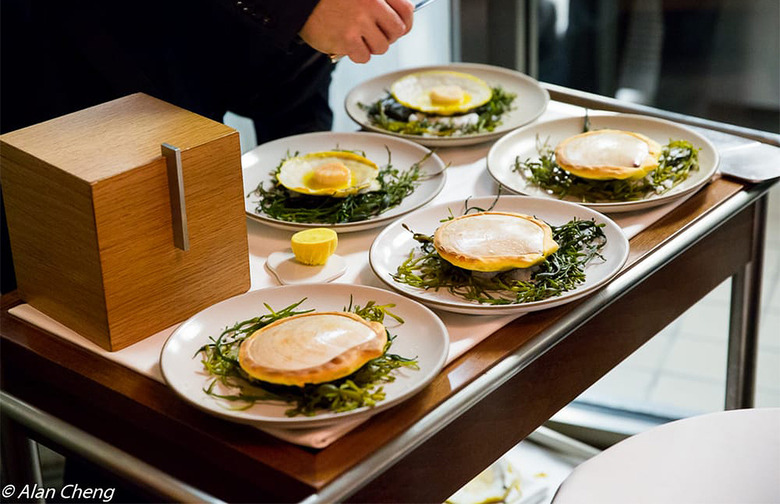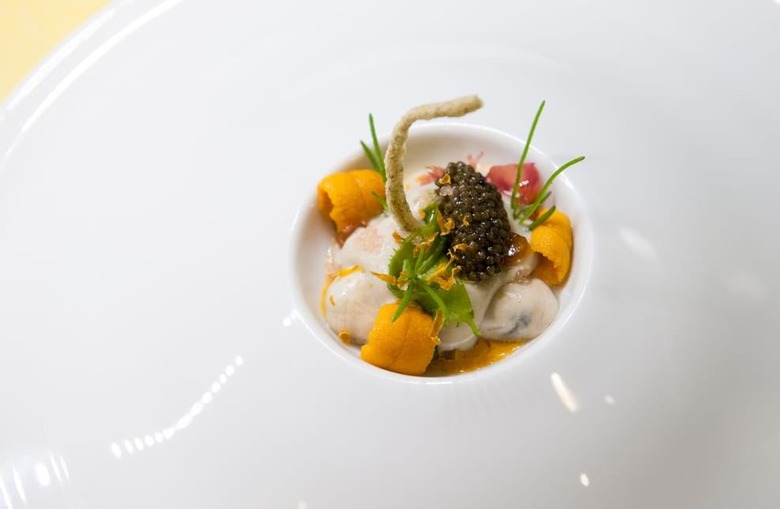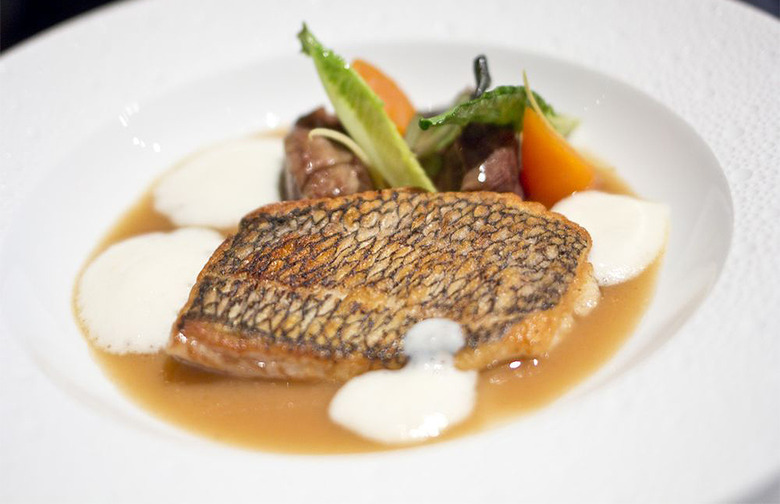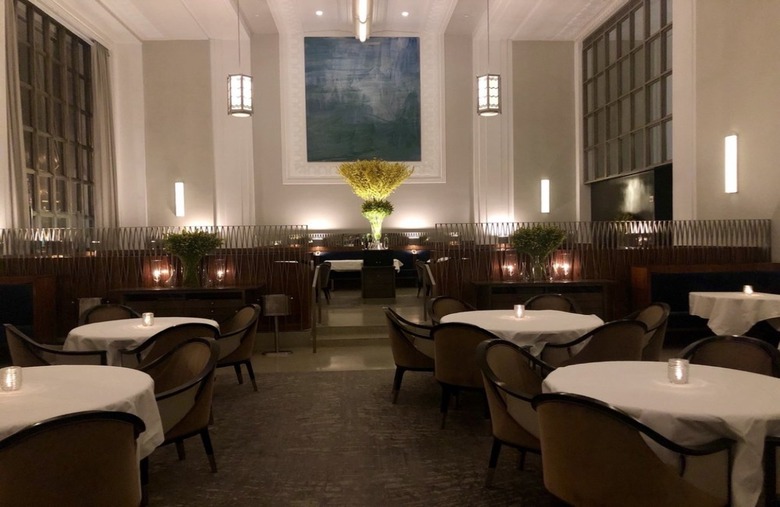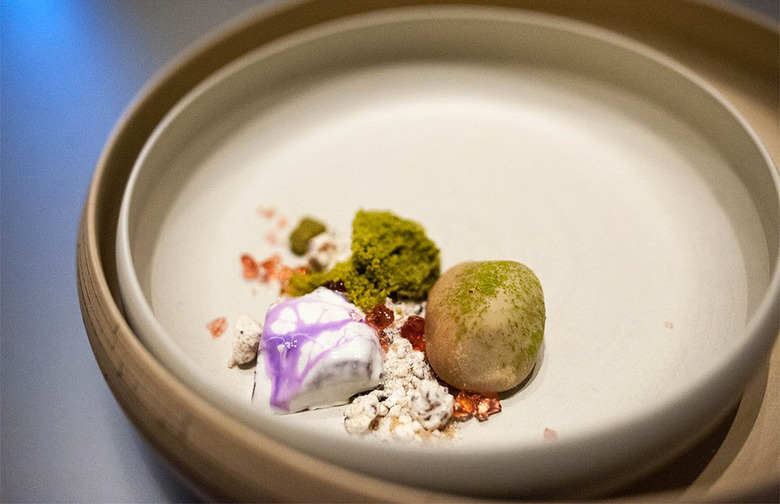101 Best Restaurants In America For 2018 Gallery
We may receive a commission on purchases made from links.
Note: This is 2018's ranking of America's best restaurants. For the 2020 ranking, please click here.
The task of choosing our nation's best restaurants — as our panelists would surely tell you — becomes more difficult every year, because the number of excellent places to eat continues to grow. As our interest in, and appreciation of, good food continues to increase — and as more great chefs train more younger good ones — fantastic food continues to spread across America. Exceptional culinary landscapes in big cities get better, while new and different dining scenes in every corner of the country are born, in turn attracting and inspiring more talented cooks. All this makes trying to rank the country's best restaurants more and more challenging, but also more and more worthwhile and intriguing.
#101 The Continental, Naples, Fla.
The blue-chip Florida Gulf community of Naples has no shortage of restaurants, at least a few of them owned by D'Amico and Partners, the Minneapolis-born restaurant development and management company. The Continental is a stylishly raucous indoor-outdoor steakhouse, featuring Iowa Premium Black Angus, Piedmontese, Japanese wagyu, and Snake River Farms American wagyu beef in assorted cuts, cooked perfectly, with sides that include the expected sautéed spinach and pommes frites, but also green and wax beans with Serrano ham butter and almonds, potato gratin with serrano ham and Parmigiano, and poutine with duck and foie gras sausage. There's non-steak too, of course — things like appetizers of yellowtail carpaccio with jalapeños, "Joe Beef" baked oysters, grilled Kurobuta pork chop, a lunchtime house-smoked, thick-sliced pastrami sandwich topped with caramelized onions and gruyère, and a spectacular burger. Lively cocktails (the Wanna Shake Your Tree combines Florida vodka with sparkling wine, peach, and basil), a nice wine list, and live music nightly complete the package.
#100 Cúrate, Asheville, NC
The name of this popular Asheville tapas bar-plus, located in this lively city's 1927-vintage former bus depot, means "cure yourself" — and if what ails you is an unsatisfied appetite for full-flavored, authentically Spanish food, you've come to the right place. Proprietors Katie Button (also the executive chef) and Félix Meana are veterans of elBulli and José Andrés' empire (they met and fell in love at one of his restaurants in Washington, D.C.), and they know their way around tapas very well. Sample their ham croquettes, patatas bravas, ensaladilla rusa, tortilla española, butifarra sausage with white beans, or vegetable paella, and close your eyes to find yourself in Spain. Desserts by pastry chef Carmen Vaquera ("gin & tonic" meringue, dark chocolate custard with orange sorbet and candied corn nuts, and such) are worth saving room for.
#99 Rustic Canyon, Santa Monica, Calif.
This beach town "wine bar and seasonal kitchen," warmly but not exactly rustically furnished, is the preserve of chef Jeremy Fox, a veteran of Manresa in Los Gatos, the now-closed ultimate-vegetarian Ubuntu in Napa, and Daniel Patterson's Plum in Oakland. He has turned what began as a very good gastropub into a confident, idiosyncratic, vegetable-glorifying (but hardly vegetarian) restaurant that deserves to be ranked among the top eating places in LA. Yes, the popular lavender-flavored almonds Fox served at Ubuntu are on the menu, and there are offerings like toasted squash seed spaetzle with delicate squash, brown butter, and sage; but then there's the porchetta and grilled Calabrian sausage with lentils and winter giardiniera, and the really hefty dry-aged côte de boeuf for two with Yorkshire pudding and green peppercorn sauce. The room is always buzzing with diners who seem very happy indeed with such fare — though the well-curated wine list (AmByth Estate biodynamic viognier from Paso Robles, Tenuta San Francesco E'ISS from Campania, four vintages of Lebanon's elegant Château Musar...) doubtless has something to do with the contentment level.
#98 Roast, Detroit
Michael Symon is one of America's most fearless, fun-loving, and unpredictable chefs, and at his entry into the Detroit dining scene, all of this is evident and more. The dinner menu at Roast contains delicious and unexpected twists including beef cheek pierogies, maple-glazed pork belly with parsnip and apple, and lobster with house-made spaghetti — and the steak selection isn't fooling around. Dishes like filet mignon with crab béarnaise, dry-aged New York strip with bone marrow and basil pesto, dry-aged ribeye with charred onion relish and watercress, and dry-aged porterhouse for two will make immediately obvious why Symon is one of Food Network's Iron Chefs.
#97 Camino, Oakland, Calif.
Chef Russell Moore opened Camino with Allison Hopelain in 2008 after spending 20 years at Alice Waters' Chez Panisse, where he wrote the menu for the upstairs cafe for at least 12 years. He has brought the same ethos of fresh, local, and seasonal foods — and daily menus — to his endeavor. There are just three fires going in the kitchen at Camino, and so there are only three rotating main courses, each the responsibility of a single cook every night. Current offerings include pickled local herring with citrus salad and fresh turmeric; slow-cooked pork and chanterelle mushroom ragù with grits and sorrel and grilled duck breast and slow-cooked duck leg with faro, cabbage, pomegranate, and almonds. The idea is for the cooks to maintain total control of everything cooked on the grill and in the wood-burning oven. That's the kind of dedication that has made the restaurant a local favorite, and Moore 2015 a semifinalist for James Beard's Best Chef: West award. Moore and Hopelain's book, This is Camino, was nominated for a 2016 James Beard Award as well.
#96 Upland, New York City
This big, bright, perpetually bustling Park Avenue establishment, part of Philadelphian Stephen Starr's ever-expanding empire, with Californian Justin Smillie in charge of the kitchen, is the perfect all-purpose eating place. At lunchtime, there's a small but well-curated assortment of salads, pizzas, pastas, and sandwiches at easygoing prices. Dinner expands into such Italianate specialties (Smillie won three stars from the New York Times for his Italian cooking at Il Buco Alimentari & Vineria) as pan-roasted gnocchi with tomato, ramps, and peperoncino; flaxseed-crusted cod with cracked wheat risotto; and Flying Pigs Farm porchetta with heirloom beans and roasted tomatoes. The brunch menu offers everything from homemade doughnuts to eggs "in hell" (spiced with fresno chiles) to spaghettini with a fried egg. The savvy international wine list includes a number of nice bottles in the $50 to $75 range — not exactly inexpensive, but palatable for a good Manhattan restaurant.
#95 Ristorante Bartolotta, Milwaukee
Renowned chef Paul Bartolotta's flagship Italian restaurant is located on the outskirts of Milwaukee, and it's been drawing guests from downtown for more than 20 years. A must-order is the Uovo in Ravioli (a single large raviolo encasing ricotta, spinach, and a whole runny egg yolk). Other standouts include hand-cut pappardelle with slow-braised duck ragù, a half chicken roasted under a brick, an assortment of grilled seafood, an oak-fired filet of beef with pureed potatoes and Umbrian black truffle sauce, and whatever happens to be on the chef's three-course seasonal menu that day.
#94 Hugo's, Houston
Hugo's opened in 2002 in a restored Latin-inspired building designed by Joseph Finger (also responsible for the Art Deco–style Houston City Hall) and launched into a diverse regional approach to Mexican food. Chef Hugo Ortega, a finalist for the 2013 James Beard Award for Best Chef: Southwest, cooks food that's elegant, inventive, and inspiring. Order the much-heralded lamb barbacoa braised in garlic and chiles then slow-roasted in agave, and, for the name alone, the manchamanteles — described on the menu as the "tablecloth stainer" — a sweet mole-stewed pork and chicken dish.
#93 Mission Chinese, San Francisco
Chef Danny Bowien's innovative San Francisco landmark mixes genres happily and successfully. The basic framework may be Chinese (though Bowien is himself Korean-born), but there's Middle Eastern tzatziki with the fried Westlake lamb dumplings, caramelized Thai fish sauce with the country-fried hamachi collar, and olive oil and Calabrian chiles with the steamed greens. And then there are the pork mapo and mushroom mapo burritos — and of course the famous kung pao pastrami. It's all done with such authority (and good flavor-sense) that nothing ever seems gimmicky. This isn't a place for timid palates — spice and pungency are the order of the day — but it's one of the most original restaurants in America. (Bowien also runs a New York City branch, serving a considerably larger menu — don't miss the thrice-cooked bacon and rice cakes with bitter melon and sweet tofu skin or the salt and pepper lamb rib tips with charred onions, dates, pickles, and sourdough pita with kefir cream.)
#92 Miller Union, Atlanta
Simple, farmstead-inspired cooking is the name of the game at chef Steven Satterfield's down-home, unpretentious Atlanta eatery, and it's earned him multiple James Beard Award nominations. An active member of Slow Food Atlanta and a regular denizen of the city's farmers markets, Satterfield transforms fresh seasonal ingredients into refined yet accessible plays on regional classics. Grit fritters with country ham and Thomasville tomme; roasted oysters with smoked oyster cream and country ham; grilled quail with pecan, celery root, apple, dandelion, and cranberry; and braised pork shoulder with polenta, mushroom, greens, and green tomato are just a few examples of what you might find on the constantly changing menu.
#91 Jitlada, Los Angeles
Jitlada, a storefront restaurant in Thai Town, has been an institution of the Los Angeles dining scene for decades, but you could argue that it gained critical mass after critic Jonathan Gold highlighted it in 2007. While it has always been known for doing all the standard Thai dishes very well, you have to credit southern Thai chef Suthiporn Sungkamee (who sadly passed away last year) and his sister Sarintip "Jazz" Singsanong for introducing southern Thai specialties that, until a few years ago, could be found nowhere else in America. Try the kua kling (dry curry beef), khao yam (Songkhia-style rice salad tossed with dried shrimp, toasted coconut, lemongrass, kaffir lime leaves, and a sweet sauce), and whatever else Jazz recommends.
#90 Taco Maria, Costa Mesa, Calif.
Carlos Salgado, who worked at Daniel Patterson's Michelin-three-star Coi in San Francisco among other acclaimed Bay Area restaurants, moved south to Orange County, opening Taco María in 2013. The place's modest-sounding name conceals a highly original restaurant of the highest quality, producing what Salgado calls "Alta California cuisine," based around the heart of true Mexican cooking: corn, of heirloom varieties grown on small farms in Mexico and nixtamalized in-house. Much as Enrique Olvera does at his Cosme and Atla in New York City, Salgado expands the possibilities of what this most vivid and varied cuisine can be. Dishes might include broccolini with chorizo and toasted almonds; black cod tacos with charred scallion aïoli, cabbage, and kumquats; and chicken with cranberry beans, hominy, and shishito peppers. The brunch menu includes a knockout variation on huevos rancheros — huevos pescador, made with smoked sturgeon and dashi hollandaise. The wine list includes a sampling of bottles from Baja California's wine country.
#89 Charleston, Baltimore
Open since 1997 on Baltimore's waterfront, Charleston is helmed by restaurateur Tony Foreman and chef Cindy Wolf, a five-time James Beard Award finalist (2006, 2008, and 2014-16).Rated the best restaurant in Baltimore by Zagat for years, Charleston's cuisine is (as the name might imply) inspired by the Lowcountry of South Carolina, but it also makes good use of local ingredients and serves to showcase Wolf's French training. There are four tasting menus ranging in price from $79 (three courses) to $124 (six courses), and the menu changes on a daily basis. Sample menu items include whiskey, foie gras, and potato soup with fresh black winter truffle oil; cornmeal-fried oysters with lemon-cayenne mayonnaise; pan-roasted wild rockfish with mushroom fricassee and lemon beurre blanc; pan-roasted New York squab with fresh black winter truffle risotto and port wine reduction; and sweetbread en cocotte with seared foie gras, maitake mushrooms, macaroni, and cognac cream. Foreman's wine list is 800 bottles strong, and definitely worth exploring.
#88 City Grocery, Oxford, Miss.
The tight-knit city of Oxford, Mississippi, opened its arms to New Orleans-born chef John Currence when he launched City Grocery in 1992 and never let go. Snag a table on the second-floor balcony if it isn't too warm outside and dine on Southern comfort favorites like shrimp and grits or a muffaletta (offered only at lunch, when you'll struggle to decide between that, the burger, and the roast beef po' boy), or indulge in delicious dishes like bourbon braised short ribs, adobo stewed chicken thighs, and apple and goat cheese stuffed pork chop with mashed new potatoes. Don't forget that Currence has created the best of both worlds for himself, something that you'll probably want to take advantage of when it comes time for a nightcap: a chef's restaurant downstairs, and the kind of bar where a chef would want to hang out after work upstairs.
#87 Bazaar Meat, Las Vegas
Having conquered Spanish cuisine both traditional (Jaleo and his Pepe food truck) and avant-garde (The Bazaar, minibar, é), the cooking styles of the Eastern Mediterranean (Zaytinya), historical American fare (the soon-to-reopen America Eats Tavern), and Mexican-Chinese (China Poblano), Puerto Rican-Spanish (Mi Casa) and Chinese-Peruvian (China Chilcano), and pan-Asian (Ku Noodle), what did the ceaselessly energetic José Andrés tackle next? Hmm. How about meat? At his Sin City venture Bazaar Meat (in the SLS Las Vegas Hotel), the menu by The Daily Meal's 2012 American Chef of the Year Andrés' is full of Spanish flavors and signature bites like cotton candy foie gras, bagels and lox cone, and Ferran Adrià olives, as well as an extensive raw bar and "meat from the sea" (fish to you), but the focus is appropriately meaty. Behold the menu of carpaccio, tartare, cured meats, and, yes, serious beef rib steaks from California, Oregon, and Washington — including a chateaubriand from the Golden State's Brandt Beef — served with truffle sauce and pommes soufflés.
#86 Fat Rice, Chicago
A good example of a modest neighborhood restaurant punching way above its weight, Fat Rice, in Chicago's Logan Square area, serves unpretentious, splendidly prepared, full-flavored dishes inspired largely by the cooking of Macau — the autonomous Chinese territory (and casino paradise) that has been called Portugal's Hong Kong. Macanese cuisine starts from a Chinese base but incorporates influences not only from its longtime Iberian colonial master but also from India — including Goa, another onetime Portuguese colony — and various parts of Southeast Asia. Salty, earthy, sourish flavors are everywhere on the unusual menu: sample such items as chili prawns with garlic and fermented black bean, traditional Portuguese potato and sausage soup, curry pork chop with potato and eggplant, and traditional Macanese "fat rice" loaded with meats, seafood, and sausages, and you'll start wondering where this unique and uniquely satisfying culinary idiom has been all your life. The small but well-curated selection of Portuguese wines is a plus.
#85 Holeman & Finch, Atlanta
This Atlanta must-visit serves one of the best burgers in America, some of the best fried chicken in America, and one of the best brunches in America, and we've ranked it as one of the best bars in America, so how could it not also be one of the 101 best restaurants in America? If the aforementioned accolades don't make it clear, this restaurant, under the auspices of master chef Linton Hopkins, serves brilliant-yet-accessible creations that will keep you enthralled time and time again. Every meal here is an adventure: Keep it simple with some pimento cheese, fried oysters, and a cheeseburger (made entirely from scratch and seriously one of the best you'll ever have), or gourmet it up with a torchon of foie gras, bacon wrapped venison loin with winter greens and potato millefeuille, or Appalachian trout with cauliflower risotto and broccoli.
#84 Chi Spacca, Los Angeles
Chi Spacca ("he who cleaves" — in other words, "cleaver" — in Italian) has been called a "meat speakeasy" with good reason. At this restaurant, accompaniments like warm salted medjool dates and roasted amberjack collars with labneh and zhug are just sideshows for the rest of this meat-centric menu. Chef Ryan Denicola's menu highlights a $220 50-ounce prime, dry-aged porterhouse bistecca fiorentina and a 36-ounce, $150 prime, dry-aged bone-in New York costata alla fiorentina. And according to the Los Angeles Times' restaurant critic Jonathan Gold, the only reason why there isn't an 80-ounce steak on the menu is "because it was pointed out that $350 was probably more than anybody was willing to spend on a piece of meat, no matter how spectacular, and that none of the tables in the restaurant seated enough people to actually finish the thing." Despite all that, it would be unfair not to note that Chi Spacca isn't about excess, but meat artistry. You could challenge yourself to discover someone more committed to the nuance and deliberation of charcuterie, but you'd be hard-pressed to find many equals to Chi Spacca's approach.
#83 Estela, New York City
What do you get when former Blue Hill at Stone Barns beverage director Thomas Carter pairs with a Uruguay-born chef who has worked with Argentinian grill-master Francis Mallmann and Slow Food icon Alice Waters, and at Isa and Il Buco? One of New York City's hottest restaurants. This NoLita gem features a relatively compact, rarely changing menu of shareable plates with a largely Mediterranean focus. Chef Ignacio Mattos' food has been described as simple in appearance while simultaneously strange but right. Perhaps it shouldn't be a surprise that the advice he gave in 2014 during an interview sounds like that of a culinary pioneer: Do your own thing, undersell and over-deliver, stop overthinking everything, and drop acid. OK, so he meant citrus and vinegar, but some of his philosophy does run counter to many current trends: Ignore the seasons, cook the familiar, lose the tweezers, and win with bread. The execution at Estela won't disappoint. Some of the chef's most heralded dishes are his beef tartare with sunchoke and his mussels escabeche. For something heartier, try the Iberico pork with cabbage and quince or steak with black sesame béarnaise and turnips. And you probably won't want to miss the burrata with salsa verde and charred bread and the endive with walnuts, anchovy, and ubriaco rosso, which is what President Obama and his wife ordered on their visit in late 2014.
#82 Everest, Chicago
True to its name, the 31 year-old Everest towers head and shoulders above many of Chicago's other upscale restaurants — literally, from its perch on the 40th floor of the Chicago Stock Exchange Building, and also gastronomically, through Alsatian-born chef Jean Joho's superlative French food. Indeed, the Chicago Tribune's restaurant critic, Phil Vettel, has called it the "best tall restaurant in Chicago" (though, as he notes, its view facing west is devoid of architectural interest — its private rooms are the ones with the city views). The menu changes to reflect the seasons, but current offerings include bouillon-on-Michigan chestnut with preserved duck confit and brioche crouton; Casco Bay sea scallops with fennel choucroute and tokay jus de poulet; and the famous Alsatian-style baked wild sea bass. The 1,600-bottle wine list stuns almost as much as the views — above all because of its collection of great wines from Joho's home region of Alsace.
#81 Rose's Luxury, Washington, DC
This small, no-reservations converted townhouse and its upstairs lounge is the brainchild of chef Aaron Silverman, who branched out on his own after spending time working for the likes of David Chang, Sean Brock, Marco Canora, and George Mendes (he won 2016's James Beard Award for Best Chef: Mid-Atlantic for his efforts, and also runs another major D.C. hotspot, Pineapple and Pearls). His small menu showcases international flavors (occasionally several in one dish) with a decidedly American twist, and even though the selection is small (just a handful of small plates, a few pastas, and two family style dishes), it's always big on flavor and creativity. Expect to find dishes like carrots "pastrami" with smoked butter, rye, and sauerkraut; pork sausage with habanero, peanuts, and lychee; Thai-marinated pork blade steak with nahm prik slaw; ricotta agnolotti with kumquat and sweet potato; and family-style smoked brisket with white bread, horseradish, and slaw. Vegetarian options are always clearly identified, prices are very reasonable, and 25 cents from every meal served goes toward feeding children in need.
#80 Underbelly, Houston
Chefs like Underbelly's Chris Shepard have helped galvanize the Houston dining scene in recent years. He insisted on an in-house butcher shop here in his first restaurant, and he works with Houston's finest ranchers and farmers for the best possible product. Underbelly's farm-to-table approach isn't the only thing that makes it stand out in a sea of Bayou City restaurants, though: the restaurant is dedicated to telling "the culinary story" of its city, reaching back all the way to its Creole roots. Expect dishes like homemade charcuterie with pickles and toast, smoked beef shoulder with pimento mac and cheese and comeback slaw, and Korean braised goat and dumplings; each dish is a nod to the city. Hits history, and its immigrants. You'll have to hurry if you want to experience Underbelly in its original form, however; it's closing in March and will be reopening with a new name — UB Preserv — and a tweaked concept in a new space later this year.
#79 O Ya, Boston
Chef Tim Cushman brings innovative sushi and related new-Japanese fare to his menu with imagination and flair, accompanied by a large choice of excellent sake and wine, in an understated dining room whose simplicity belies the complexity of flavors on the plate. Cushman won the 2012 James Beard Award for Best Chef: Northeast. At this North End sanctuary, you can expect to enjoy dishes like hamachi with yuzu soy marinated Chilean sea urchin; Ora king salmon with unfiltered wheat soy moromi (the mash from which sake is fermented); and yuzu-cured Arctic char with sesame brittle, cumin aïoli, and cilantro. For a truly unforgettable O Ya experience, try to get a seat at the counter to watch the delicious food being created before you in what is definitely one of America's best sushi restaurants. And with a second sushi outpost (as well as a Mediterranean-themed place, Covina) in New York, Cushman is sharing the love.
#78 Oyster Club, Mystic, Conn.
As the name suggests, this small, coastal New England restaurant and bar is famous for its oysters. They're shucked at the tiny raw bar, and the day's offerings are scrawled on a driftwood chalkboard. With six draft beers, 200 wines by the bottle and 16 by the glass, a range of spirits focused on whiskey, and eight signature cocktails, The Oyster Club offers a tipple to suit all tastes. Chef James Wayman is plugged in to all the best producers in eastern Connecticut, and his handwritten, daily-changing, farm- and-sea-to-table menu offers everything from clam chowder (New England or Rhode Island style) to a handmade rye ramen with simmered tofu and mushroom dashi to the popular burger (seared on cast iron and served with Grafton Cheddar, smoky bacon, Worcestershire mayo, caramelized shallot, and a brioche bun with house-cut fries.) There's a nose-to-tail aspect to the cooking, too; recent offerings have included goose liver mousse with date mostarda and bucatini with duck hearts, kidneys, and gizzards. Simpler fare, much of it wood-grilled, is served in summer months in an open-air Treehouse upstairs.
#77 Topolobampo, Chicago
Topolobampo is named for a port city on the Gulf of California in northwestern Sinaloa. At this slightly fancier and more ambitious next-door cousin of his popular Frontera Grill, Rick Bayless serves irresistible Mexican fare of a kind not found outside some of the better restaurants of Mexico itself, if even there. It's hard to believe that this Chicago institution is now more than 25 years old, especially since a redesign a couple years ago gave the restaurant a brand new feel, one that has critics falling in love with it all over again. Dishes are served in three different tasting menus: A five-course $90 Winter Tasting (including slow-roasted suckling pig with red chile and chestnut mole), a five-course $100 Classic Tasting (including wood-grilled Imperial Wagyu carne asada and ocean trout with cranberry escabeche), and a seven-course $120 Pre-Columbian menu, made entirely with indigenous Mexican ingredients.
#76 Barley Swine, Austin
This eight year-old Austin hotspot features a constantly-changing seasonal menu that revolves around showcasing seasonal local ingredients and isn't afraid to have a bit of whimsy. Guests have the option of noshing on a selection of shared plates or springing for a 10-course Chef's Tasting (reasonably priced at $95). Small plates may include Akaushi beef tartare with beer-battered kale; pig skin noodles with hot sauce, almond, and shrimp; smoked carrot with chèvre and mushroom chili; and pig face carnitas with sweet potato, apple, and pecan; the current Chef's Tasting features popcorn custard with chicken skin; Gulf shrimp with cauliflower and kalamansi; glazed duck ham with grilled broccoli and fried duck egg; and hay ganache with winter nuts and milk jam. Be sure to check out the stellar beer list, and don't miss the killer happy hour, "Swine Time."
#75 Valentino, Santa Monica
For more than 40 years, Piero Selvaggio's Santa Monica landmark Valentino has set the standard for Italian fine dining in America. He served real Italian pastas and things like radicchio and balsamic vinegar when they were exotic in this country; he absorbed the inspirations of the nuova cucina and modernized his menu without losing touch with the homeland; he survived earthquakes and economic downturns and the onslaught of new, hip places that could have pushed his restaurant into the Boring Old Standby category — but didn't. Today, he is increasingly turning back to Italian regional cooking — especially that of Sicily, where he comes from, and Sardinia, birthplace of chef Nico Chessa. Yes, you can have prosciutto and melon or spaghetti alla carbonara here, and they'll be impeccable, but why not try the crudita di pesce (Italian "suchi" marinated with citrus and colatura di alici, a kind of anchovy syrup), the lasagne della nonna (grandmother's lasagna) with mushroom and duck ragù, or the veal ossobuco with risotto milanese? The wine list is one of the largest and richest in America, and service at this, one of The Daily Meal's Best Italian Restaurants in America, is perfect.
#74 Café Annie, Houston
Daily Meal Council member Robert Del Grande was one of the pioneers of modern Southwestern (or modern Texan) cooking. He cooked French food when he first took over the kitchen at his sister-in-law's restaurant, Café Annie, back in the early '80s, but gradually started working Tex-Mex and other Southwestern influences into his cooking. Rabbit enchiladas, made with leftover meat from a French-style preparation, became his first signature dish, and over the years he added such delights as black bean terrine, crabmeat tostadas, and coffee-rubbed tenderloin of beef. The original restaurant moved in 1989. Two decades later, the second location was torn down to make room for a new mixed-use complex, in which Del Grande installed an updated version of the restaurant, dubbed RDG & Bar Annie. In 2016, the place reverted to Café Annie, with an emphasis on aged steaks (including that tenderloin) and prime rib, plus Gulf seafood, assorted ceviches and sashimis, and "Texas Signatures" like wood-grilled quail with Hill Country venison sausage, juniper, and Texas honey. An enchilada of the day (sometimes rabbit), crispy chicken flautas, and Mexican steak tacos are available at lunchtime. Del Grande's repertoire continues to expand, and the cooking just keeps getting better.
#73 Lucques, Los Angeles
Chef Suzanne Goin was nominated for the James Beard Outstanding Chef of the Year Award every year from 2008 to 2013 for her first endeavor, Lucques, which opened in 1998 and remains as good as ever. The restaurant shines with a warm dining room, an enchanting patio, and a menu of bright, full-flavored food (winter greens with shaved beets, avocado, pomegranates, blood orange, and the spicy herb-and-chile Middle Eastern relish called zhoug; grilled harissa chicken paillard with chickpeas, fennel, mint, cucumber yogurt, and feta), based around raw materials from sources "guided by principles of sustainability." This is one of those places that doesn't try to break new ground every day; it just gets everything right.
#72 Fearing's, Dallas
Located in The Ritz-Carlton, Dallas, Fearing's features modern Southwestern-American cuisine with a farm-to-table approach. Indeed, along with Stephen Pyles and Daily Meal Council member Robert Del Grande, chef Dean Fearing (also a member of The Daily Meal Council) kind of wrote the book on modern Texan cooking (one of his cookbooks is literally called The Texas Food Bible). What does "modern Southwestern-American cuisine" mean? Barbecued shrimp taco with mango and pickled red onion; barbecued short rib enchilada with queso fundido; mesquite-grilled wagyu ribeye with West Texas mop sauce; and "Texas carpaccio" — wagyu beef with Texas olive oil, grana padano, crispy capers, and pickled golden beets. With many dining venues on-site, diners can choose from anything from the outdoor patio to the more upscale Gallery. If you're dining chef-side in Dean's Kitchen, or at the Chef's Table, look for the ebullient chef; he's almost always present. And make sure to order his signature tortilla soup.
#71 Norman's, Orlando
Known as the founding father of New World cuisine, chef Norman Van Aken — a member of The Daily Meal Council — is acclaimed for his fusion of Latin, Caribbean, and Asian flavors using traditional European techniques. At Norman's in the Ritz-Carlton Orlando, guests can eat in the opulent dining room or on the restaurant's outdoor terrace overlooking the hotel's lake, 18-hole Greg Norman-designed golf course, and lush gardens. (Norman's was ranked No. 37 on The Daily Meal's list of the Best Hotel Restaurants Around the World.) The menu changes according to availability of seasonal ingredients; it currently features Florida cobia "aguachile"; guava-pasilla grilled pork chop with malanga-celeriac puree, chayote, and wild mushroom farro; and pan-cooked Atlantic wreckfish with squash puree, sweet potato gnocchi, and maduro.
#70 Scampo, Boston
James Beard Award-winning chef and Daily Meal Council member Lydia Shire is one of Boston's legendary chefs, and her restaurant, Scampo, is one of the best Italianish restaurants you'll ever dine at. While Italian at heart, Shire isn't afraid to incorporate a tandoori oven or Spanish ibèrico ham into the mix, and the menu is fun and playful. Handmade breads come in seven varieties. There's a full "mozzarella bar" five different seasonal fresh mozzarella-based dishes (just opt for the mozzarella tasting, you know you want to). Spaghetti comes topped with cracklings and hot pepper and pizza is topped with white clam and bacon, among other things. Entrées include brick chicken with black garlic purée and Meyer lemon risotto, cotechino sausage ravioli with truffle foam and purple kale, and braised short rib with whipped celeriac. It's one of those menus where literally everything looks delicious... but we'll be waiting for Friday night, when the special is roast suckling pig.
#69 Alan Wong's, Honolulu
When your restaurant essentially defines a cuisine, it's a safe bet that you should keep on doing what you're doing. Such is the case at Alan Wong's, a Honolulu landmark where Wong's high-end regional Hawaiian dishes, including butter-poached lobster with abalone, mushrooms, and green onion oil, and crispy won ton-wrapped ahi poke balls with avocado and wasabi sauce, have been making a culinary statement since 1995. And with a close relationship to Hawaii's farmers and agricultural society, Wong's Farmer Series dinners hit close to home for natives and tourists alike. Make sure you start your meal with the local butter tasting.
#68 Highlands Bar & Grill, Birmingham, Ala.
This legendary restaurant was focusing on local and sustainable ingredients before anyone coined the phrase "locavore." Highlands Bar & Grill put the Birmingham dining scene on the map when it opened in 1982, and chef and co-owner Frank Stitt, a member of The Daily Meal Council (who runs it with his wife, Pardis) has already been inducted into the James Beard Foundation's Who's Who of Food & Beverage. The restaurant has been nominated for Outstanding Restaurant seven times. What to expect from a meal at Highlands? It's sometimes best to hear it straight from the source: "We serve a daily changing menu informed by classic French technique, incorporating the foods of our Southern region. We love the ever-changing basket that each harvest allows, from the first springtime shad roe to the blue-green live and kickin' soft shell crabs that arrive a few weeks later. Summer's shell beans, tomatoes, okra, and watermelon bring a smile. The cooler weather game of venison and quail, root vegetables, and greens creates sustenance. Our dishes are prepared with respect and restraint to allow each ingredient's inherent goodness to shine through."
#67 Gotham Bar & Grill, New York City
Most New York City restaurants would consider themselves lucky to even get a review in The New York Times. Since it opened in 1984, Gotham Bar and Grill has been reviewed no fewer than six times by the Gray Lady. Even more impressive, it has scored 15 stars — five three-star reviews (four is the best) since chef Alfred Portale took over in 1985. The culinary style might be called classic new American, which translates to such dishes as yellowfin tuna tartare with Japanese cucumber, shiso, and sweet miso ginger vinaigrette; seared Hudson Valley foie gras with fresh figs, toasted almonds, oats, dried fruit compote, and date purée; and grilled branzino with cranberry beans, chorizo, caramelized fennel, cippolini onions, and romesco. Want to hear a fun fact about Portale's signature stacking style for plating food? The chef said it originated out of him trying to find ways to do more with less. "Rather than trying to cook a big piece of fish, I'd cut it into two thin pieces and then stack them."
#66 Frasca Food & Wine, Boulder
In the Friuli region of northeastern Italy, a frasca is a roadside farm restaurant, serving simple regional food. Frasca Food & Wine captures the spirit of these venues, while also championing the vast diversity of Colorado's unique culinary resources. Owners Bobby Stuckey and Lachlan Mackinnon-Patterson have created a warm and inviting space that can accommodate an impromptu dinner or an evening of fine dining. They offer three unique menus that change daily – a four-course menu for $85 (with dishes also available à la carte); a "Friulano Tradizionale" menu of Friulian regional specialties for $115; and a $50 four-course Monday tasting menu.
#65 Babbo, New York City
Critics, philosophers, and pop-culture columnists have long argued, some more articulately than others, about whether we can separate the art from the artist. Can we appreciate the skills of a Roman Polanski, a Floyd Mayweather Jr., knowing what we do about how they've treated their fellow man and (especially) woman? How about a Mario Batali? Batali has indisputably influenced the American culinary landscape, through his restaurants, cookbooks, and TV shows, as well as his and his partners' multi-unit Italian market Eataly. Do the accusations made against him (which Batali doesn't seem to have refuted) suggest — or demand — that we shouldn't patronize businesses with which he is or was associated? That's a decision each of us has to make personally (presumably bearing in mind that a complex commercial empire like Batali's employs a great many people who are likely innocent of misbehavior but who would be affected by a Batali boycott). On the basis of present evidence, not many diners feel the need to avoid Batali's flagship, Babbo. Although it will turn 20 this year, it's still difficult to get a table there — even after damaging revelations about its creator. The art, in this case as in so many others, seems to transcend the artist. Must-order dishes? Considering that the menu has become its own greatest hits list, that's a tough call. You can explore Italy by land and sea with things like grilled octopus in spicy limoncello vinaigrette or pig foot milanese, but you'll probably want to make sure you at least try the mint love letters with spicy lamb sausage; black spaghetti with rock shrimp, spicy salami calabrese, and green chiles; and beef cheek ravioli.
#64 Animal, Los Angeles
It's hard to believe that just seven years ago, chefs Jon Shook and Vinny Dotolo were considered culinary renegades for showcasing dishes like crispy pig head with short-grain rice, bulldog sauce, and soy egg; marrow bone with chimichurri and caramelized onions; and crispy sweetbreads with black sriracha and finger lime. Despite (or because of) their reputation as extreme carnivores, Shook, Dotolo, and their restaurant Animal became mainstays of the American culinary scene, and their creations kept chefs and civilians coming back for more. At this point, Shook and Dotolo are practically part of Los Angeles old guard, with other endeavors, like Trois Mec, Son of a Gun, Petit Trois, the French-Mexican daytime-only Trois Familia, and their "California Italian" joint Jon & Vinny's taking up some of their attention. But the small, loud, and perpetually crowded original that brought them fame still sets the standard for uncompromising, All-American (read: multi-accented), straightforward cooking. Where can you order veal brains with vadouvan, apricot purée, and carrots or a foie gras/loco moco/quail egg/Spam burger?
#63 Fore Street, Portland, Maine
Fore Street's wood-roasted menu has been bringing diners in steadily since 1996. Locally harvested mussels, diver scallops, turnspit-roasted chicken and pork loin, marinated hanger steak, and other basics, accompanied by vegetables grown or foraged from nearby farms and fields, are the staples of the seasonally changing menu here. Fore Street is all about hearth, rustic charm, and a lack of artifice. The open kitchen center stage fascinates, its chefs behind a vast butcher block working the brick oven as open flames lick the meat that turns on a rotisserie, embers flying. Co-owner and chef Sam Hayward was a pioneer in locally derived, simply cooked restaurant fare at Fore Street. While this farm-to-table location brings the freshest menu to the north side of town, Hayward's Portland restaurant family has grown to include Street & Company and Standard Baking Company, and Scales.
#62 Lantern Restaurant, Chapel Hill, NC
For many, chef Andrea Reusing's Lantern needs no introduction. The Asian cuisine-inspired restaurant with a strong priority for using North Carolina ingredients and has won widespread recognition. Chef Reusing is the winner of the 2011 James Beard Award for Best Chef in the Southeast, and the restaurant was a semifinalist for the prestigious James Beard Outstanding Restaurant award this year. The menu is variable, but standouts include red-cooked Chapel Hill Creamery pork shank with star anise, steamed lotus leaf rice, Edward's ham, local mushrooms, and braised watercress.
#61 The Greenhouse Tavern, Cleveland
The flagship restaurant of acclaimed Cleveland-born chef Jonathon Sawyer, who won a James Beard Award (Best Chef: Great Lakes) in 2015 for his efforts, The Greenhouse Tavern has played a huge role in putting Cleveland back on the culinary map. Sawyer's signature style and sense of whimsy translates to a meat-heavy menu that's full of bold, smoky, tangy, umami-rich flavors, and he's turning local ingredients into dishes you have to see (or eat) to believe. These include crispy pig ears with sesame barbecue sauce and crispy shallots; foie gras steamed clams with butter and red onion brûlée; barrel-aged Tabasco fried chicken; smoked pork tongue and braised pork cheek tacos on tortillas made with Ohio corn; pan-fried pork chop saltimbocca with country ham, scrapple, and red-eye gravy; fries topped with bacon, fried eggs, whole grain mustard, mozzarella cheese curds, and brown gravy; a roasted pig head with barbecue sauce, raw vegetable salad, brioche buns, lime, and lettuce cups; and one of the city's finest burgers. If it's not already obvious, a meal at The Greenhouse Tavern is a culinary adventure, a ride that you'll want to take again and again.
#60 Galatoire's, New Orleans
A Bourbon Street landmark, Galatoire's has been serving classic NOLA-style Creole cuisine for many generations. (It was opened by French immigrant Jean Galatoire in 1905 in a space that had been a restaurant since 1830.) The downstairs dining room is like a time warp, with high ceilings, slow-moving paddle fans, mirrors, black-and-white tiled floors, and brass coat hooks lining the walls all the way around the room (gentlemen must wear jackets after 5 p.m. and all day on Sunday). There's an immense menu executed by chef Michael Sichel that has changed little over the past century-plus, and the cooking is far better than it probably has to be. You'll want to sample old-fashioned fare like turtle soup au sherry, oysters en brochette, seafood okra gumbo, a variety of seasonal fish and shellfish, chicken Clemenceau, and black bottom pecan pie for dessert. Whatever you do, be sure to order the most frequently requested recipe), the shrimp rémoulade, and also the legendary soufflé potatoes, which you have to try in order to understand just how special they are. These days, anyone can get good cooking here (you used to have to wait in line), but go with a regular if you can; that way you'll be guaranteed good service (regulars have their "own" waiters) and maybe a taste of something not on the menu.
#59 Bestia, Los Angeles
Located in an old industrial warehouse in the Arts District of downtown LA, the only clue tipping diners off to Bestia's location is its spray-painted name and valet stand in the alley by the main entrance. Inside, Bestia has an upscale urban architectural feel with exposed brick walls, concrete floors, and an open kitchen where chef Ori Menasche (who owns the restaurant with his wife, pastry chef Genevieve Gergis) turns out near-miraculous Italian-inspired creations that have made his restaurant one of LA's toughest reservations since it opened three years ago. Standout menu items include a wide selection of housemade salumi, roasted marrow bone with spinach gnocchetti, pizza with housemade spicy 'nduja and black cabbage, and spaghetti with lobster and sea urchin. A kitchen fire in August shut down the restaurant, but it reopened two weeks later.
#58 Avec, Chicago
Paul Kahan's Mediterranean-meets-Midwestern shared-plates Chicago landmark, Avec, in business since 2003, was originally conceived as a wine bar. While wine is still one of the restaurant's highlights (with 130 bottles priced between $20 and $90), this surprisingly affordable Certified Green restaurant has built its reputation on turning fresh local Midwestern ingredients into unique interpretations of traditional Mediterranean fare. Chef Perry Hendrix (who took over for James Beard winner Koren Grieveson in 2010) is turning out small plates including whipped brandade with garlic bread and chives, sea urchin bruschetta with cured ham and pickled mustard seeds, and an $18 butcher's steak with squash-almond risotto and celery root; large plates include whole roasted fish with caldo verde, clams, mussels, sunchokes, and piri piri butter; wood oven paella with confit chicken, snail boudin, shrimp, and tangerine aïoli; and slow-roasted pork shoulder with Tuscan kale ribollita and apple and ricotta salata vinaigrette. With 24 hours' notice, you can also get a whole roasted lamb shoulder with pita, meze, and sauces. Don't skip the cheese plate.
#57 Momofuku Ssäm Bar, New York City
Meals at this ever-evolving East Village hot spot have wowed critics and won faithful followers since the beginning, and no wonder. David Chang's food offers bold, Asian-inspired flavors — like his duckaholic lunch and popular bo ssäm dinner (slow-cooked pork shoulder, oysters, rice, kimchee, and sauces to be wrapped in bibb lettuce leaves). Chang continues to be the culinary cool kid while cementing his status as a top-tier chef by constantly expanding his empire, and everything he touches seems to turn to gold (a rare misstep, Momofuku Nishi, was wisely revamped as an Italian restaurant in October to generally positive reviews). As an influence on younger chefs, as an animator of the downtown New York restaurant scene, and as a really good cook, Chang deserves all the praise he's received.
#56 Pêche, New Orleans
Pêche demonstrates that chef Donald Link can glorify fish just as well as he does pork (principally at his celebrated Cochon). Named one of Bon Appétit's Top 50 New Restaurants in 2013, and the home of James Beard Award winners for Best Chef South Ryan Prewitt and Stephen Stryjewski, the restaurant is centered around a coal-burning open hearth. The daily whole grilled fish — no matter what it is — is always a smart choice, but shrimp toast, smoked tuna dip, curried shrimp bisque, seafood gumbo, and crawfish with jalapeño capellini are all addictive. Classics like smothered catfish shouldn't get overlooked, either, and you'd do well to just start out with a seafood platter.
#55 Melisse, Santa Monica, Calif.
The chef-owner of this elegantly accoutered Santa Monica dining room, Josiah Citrin, is an old pro — his résumé includes stints at the once-three-star Vivarois in Paris, Wolfgang Puck's innovative Chinois on Main, and Joachim Splichal's landmark Patina — but there's nothing tired about his cooking. The unfailingly delicious specialties he serves on the various tasting menus — he has two Michelin stars of his own here — range from beet salad with olive oil panna cotta, red endive, blackberries, cocoa nibs, almonds, and balsamic vinegar to black bass with bitter leaves, stinging nettles, and grapefruit vinaigrette and on to coriander-crusted Libert Farms duck with turnips, tangerines, and sauce à l'orange, all superbly and consistently prepared.
#54 Trois Mec, Los Angeles
The darling of the Los Angeles fine-dining scene, Trois Mec is a collaboration between celebrity chef Ludo Lefébvre and Jon Shook and Vinny Dotolo, those Animal and Son of a Gun pioneers of nose-to-tail dining in Southern California. Trois Mec (which loosely translates to "three guys") is one of the growing number of restaurants that sells tickets instead of offering reservations, so getting into this former strip mall pizzeria to sample the five-course menu ($110 per person, not including alcohol) can be a challenge (tickets go on sale the first friday of every month, for that month's reservations). When you do get in, however, expect to be treated to one of the most cutting-edge dinners in California — and perhaps even the country. What does that mean? In the past, dishes like Dungeness crab ceviche; butter-poached white asparagus from the Netherlands with chicken wing confit, English peas, and a dab of chicken liver mousse; and beef tenderloin with smoked peanut butter. Buckle up and enjoy.
#53 Canlis, Seattle
Canlis is a true Pacific Northwest landmark. It's been open since 1950, serving fresh, seasonal dishes that are more polished than cutting-edge in a rustic-modern space whose use of native wood and stone evokes forests and streams. Canlis was revolutionary when it opened due to its stunning architecture (Roland Terry and Pete Wimberley collaborated on an original design meant to echo Frank Lloyd Wright) and trailblazing menu of upscale Northwest cuisine (which founder Peter Canlis essentially invented), and it's still blazing new trails while keeping the classics, such as the famous Canlis salad (romaine, bacon, mint, oregano, and Romano with a dressing of lemon, olive oil, and coddled egg), on the menu. The restaurant's onetime chef Jason Franey, who left four years ago to take over the kitchen at Restaurant 1883 in Monterey, called his cooking at Canlis "Comfort Geek" cuisine, defining that as "pertaining to a style of cuisine, namely, that which uses modern technique without drawing too much attention to itself or alienating the diner." That idea seems to have remained in place with chef Brady Williams at the helm (who came over from Roberta's in Brooklyn), with a menu offering a tasting menu-only experience of both classic and contemporary dishes, among them wagyu steak tartare and sautéed spot prawns, both based on Peter Canlis recipes; Dungeness crab with turnip, miso, and egg yolk; lamb with cauliflower, pearl onion, and mint; and cod with pickled root vegetables and clam veloute. Note that current co-owners Brian and Mark Canlis try to maintain the restaurant's reputation as Seattle's dressiest restaurant by requesting that men wear a suit or a sport coat.
#52 Café Boulud, New York City
After a succession of three fine chefs — Andrew Carmellini, Bernard Chemel, and Gavin Kaysen — helped earn and maintain a sterling reputation for this stylish, polished French-with-international-accents establishment on the site of overseer Daniel Boulud's original Restaurant Daniel, Aaron Bludorn — who had worked at the lamented Cyrus in Napa when it won its second Michelin star — is keeping up the standard. Boulud obviously knows how to pick 'em. Bludorn can go traditional and do it well (striped bass with pommes purée, baby leeks, and sauce meurette). He can evoke the season vividly (beef Wellington with rutabaga, celery root, cabbage, Dijon mustard, king trumpet mushroom, and sauce au poivre), and he seems to have an instinctive touch with the regional and international cuisines celebrated on the menu's "Le Voyage" section (currently, Japan is honored with, among other dishes, Hokkaido scallops with Hakurei turnip, uni, kabocha squash, and orange-miso reduction). In the ever-changing upscale restaurant landscape of Manhattan, Café Boulud maintains an admirable consistency.
#51 Spiaggia, Chicago
Decades before the likes of Mario Batali and Michael White reimagined fine Italian dining, Tony Mantuano taught Chicagoans how to enjoy refined Italian fare at Spiaggia ("beach" in Italian). Mantuano has won countless accolades, including the 2005 James Beard Award for Best Chef in the Midwest, and was named Best Italian Restaurant in Chicago by The Daily Meal. Reopening after a redesign in 2014 (its first since 1999), the restaurant added 50 percent more seats with views, a new lounge, and a floor-to-ceiling glass-enclosed, temperature-controlled wine room showcasing 1,700 of Spiaggia's nearly 5,000 bottles. The new restaurant menu follows the traditional Italian courses of antipasto, pasta, secondi, and dessert, but with almost entirely new dishes. One thing that hasn't changed is Spiaggia's ability to delight diners. Much of that can be credited to Mantuano and chef de cuisine Joe Flamm, who serves mouthwatering fare like duck tortellini with cherry, pistachio, and Parmigiano-Reggiano; dry-aged bistecca alla fiorentina with truffle hollandaise, turnip, and onion jam; and their famed gnocchi with black truffle, ricotta, and Parmigiano-Reggiano. A five- or eight-course tasting menu is also available, for $95 and $145, respectively.
#50 Vetri, Philadelphia
In this little jewel box of a place, now nearly 20 years old, chef Marc Vetri (who sold his restaurant group to Urban Outfitters in 2015 but retains ownership of this place) offers diners sophisticated, hand-crafted Italian and Italianate specialties, served only in the form of multi-course tasting menus. Available items are listed under Antipasti, Pasta, Secondi, and Dolce (dessert); chef de cuisine Joe Delago will personalize the menu to your taste. You might end up with, for instance, roasted cauliflower with bagna cauda, lumache with duck ragù, guinea hen with seasonal mushrooms, and chocolate polenta soufflé for dessert. All is served with precision and grace, and there is a wine cellar of more than 2,500 bottles to choose from.
#49 Peter Luger, Brooklyn
When you sit down at your table at the perpetually packed Peter Luger, located in an off-the-beaten-path corner of Brooklyn's Williamsburg neighborhood, don't ask for a menu. Just order the tomato and onion salad, thick-cut bacon, creamed spinach, hash browns, and steak for two — a massive porterhouse, broiled under extreme heat before being sliced, briefly broiled again, and presented on a platter. Sure, the wait staff might be a bit gruff in this surprisingly casual German-styled steakhouse that's been here since 1887, but that's all a part of the show. The star attraction, the steak, is among the best you'll find in New York City. It's dry-aged and butchered on-premises, and when it's presented, in all its crusty, well-marbled, beefy glory, your jaw will drop. Use the house steak sauce to douse the onions and tomatoes (don't let it anywhere near the steak), and bring a debit card or be prepared to drop a wad of cash on the table before leaving — no credit cards accepted here, big spender.
#48 Beast, Portland, Ore.
Much of the charm at Beast, apart from that provided by the wide-ranging modern American menu (need we add that it's local and sustainable in nature?), comes from family-style dinners served in an intimate atmosphere not much bigger than four or five of Portland's famed food carts. Chef–owner Naomi Pomeroy accepts just enough reservations for two six-course dinner seatings (6 p.m. and 8:45 p.m.) Wednesday through Saturday, as well as two three-course brunch services and one dinner service every Sunday. Patrons dine at a pair of communal tables (the restaurant seats just 24), where they are served the prix fixe menu of the day ("substitutions politely declined"). The particulars change weekly (the menu for the upcoming week is posted each Tuesday), but, just as an illustration of the range and imagination here, the house charcuterie plate might include steak tartare with quail egg, foie gras bon bon with peanut shortbread, Calabrian chile pork sausage, and pork and duck pâté with green garlic. Those lucky enough to snag a seat at the tables are sure to be treated like family (the best spot in the house, at the corner of the prep table in the center of the kitchen, only seats two). Those unable to get in can at least now go across the street to dull the pain at Expatriate, the cocktail lounge Pomeroy opened in 2013, where they can choose from a small menu divided into Biggie Smalls (think shrimp toast and James Beard's onion and butter sandwich), Salad Days (Chinese broccoli and Laotian tacos), and Hungrier (American-style burger, rice waffle and hot fried chicken strips).
#47 Zuni Cafe, San Francisco
Zuni Cafe showcases San Francisco Mediterranean cooking at its best. Although award-winning chef-owner Judy Rodgers passed away in December of 2013, her business partner, Gilbert Pilgram (a Chez Panisse alumnus), continues to run the place, with Rebecca Boice now in the kitchen. Zuni has been an iconic California restaurant for what feels like forever, so it may be easy to forget that when it opened in 1979, it was dedicated to authentic Mexican food. The seasonal and organic ingredients are always impeccable, and the fish and meats are sustainably raised. The whole, brick-oven-roasted chicken for two with warm bread salad, scallions, garlic, and mustard greens is among the emblematic dishes (keep in mind it takes approximately an hour to prepare) in this food-mad town, and the house-ground grass-fed burger on rosemary focaccia with aïoli and house-made pickles (lunch only) is epic.
#46 ABC Kitchen, New York City
ABC Kitchen is a celebration of the best ingredients that each season has to offer, all served in the classically elegant style for which Jean-Georges Vongerichten is widely known. The original driving force behind ABC Kitchen, Dan Kluger, left in mid-2014 to work on his own projects (his Loring Place opened in 2016), but current executive chef Ian Coogan hasn't missed a beat. Market-fresh dishes like roasted carrot and avocado salad with crunchy seeds, sour cream, and citrus stand alongside a pleasing selection of house-made pastas, whole wheat crust pizzas, and creative entrées. The décor is fresh, with an utterly cool urban sophistication that pairs perfectly with the style of the home furnishings store it's connected to, ABC Carpet and Home. The restaurant remains in the rotation for serious restaurant-goers in New York City.
#45 é by José Andrés, Las Vegas
The ceaselessly inventive — hell, the ceaseless — Señor Andrés is the king of Spanish food (among other things) in America, bringing us authentic ingredients and preparations in the traditional mode, but also giving us a made-in-America taste of avant-garde Spanish cooking as invented by his mentor, Ferran Adrià. Hidden away inside Andrés' Jaleo in The Cosmopolitan of Las Vegas, é is a kind of sibling to Andrés' minibar in Washington, D.C. — though he says it's more conservative than that hotbed of creativity. That's "conservative" like truffle-flavored cotton candy, crispy chicken skin en escabeche, turbot with crispy bone marrow and coffee grounds, and cocoa paper with dried strawberries.
#44 Momofuku Ko, New York City
After David Chang moved the noodle bar that launched his career, he filled its space in 2008 with Momofuku Ko ("son of Momofuku"), a simple counter with a handful of stools and chefs preparing a constantly changing tasting menu in full view of the diners' tasting menu spot. It made him even more famous. The no-frills space had so many clamoring for a seat that the restaurant implemented what seemed then like an outrageous online-only reservations system that spawned its own black market. Media, culinary elite, and curious diners started waking up early to furiously click on a possible Momofuku Ko reservation link before it disappeared. One can argue that the city, and the nation's restaurant scene, hasn't been the same since. But Chang decided to close the most upscale and in-demand of his restaurants to re-open several blocks away, where he gained 10 seats around a black-walnut counter, a six-stool bar, five times the wine storage, and a private dining room. Diners hoping to enjoy the multi-course, two- to two-and-a-half-hour tasting helmed by Momofuku veteran chef Sean Gray, however, will find that reservations are just as tough to get as ever, but if you snag a table expect to encounter dishes like chicken fried oyster puff with aïoli, uni with chickpea purée and olive oil, and beef that's been aged for nine weeks.
#43 Coi, San Francisco
Chef Daniel Patterson shocked the culinary world in 2015 when he decided to leave the restaurant where he made his name, Coi, in order to pursue other endeavors (including fast-casual concept LocoL with Roy Choi) and turned the kitchen over to Matthey Kirkley. Since taking over in January 2016, Kirkley (formerly of Chicago's late L20) has shifted the menu from Paterson's vegetable-centric menu towards a more seafood-oriented repertoire, with spectacular results. On the $250 11-course tasting menu you'll find citron marshmallow with oxtails and red radish; Dungeness crab with citrus leaves and black sesame; sturgeon with roasted chicken, caviar, bay leaf, and tarragon; and beef with black trumpet mushroom and fermented pepper toffee.
#42 Masa, New York City
Former New York Times critic Sam Sifton took Masa down to three stars from the four given to it by his predecessor, apparently in part because they made him wait outside when he showed up early, didn't explain all the dishes, and didn't pay him much attention after dessert. That doesn't seem to have discouraged the high-rollers who crowd the sushi bar or — losing some of the immediacy of the experience — sit at one of the small tables. Masa's toro-stuffed maki rolls have been known to inspire lip-twitching and eye-rolling, and the toro with beluga caviar seems almost worth the price of admission. And what a price that is: The swanky Time Warner Center setting and elaborate omakase-only menu is accompanied by a high bar for entry. At an astonishing $595 per person before beverages (service included; they did away with tipping a couple years ago), you're looking at a bill that can easily total more than $1,500 for two.
#41 Minibar, Washington, DC
They really have tried to make it easier on everyone, but getting into minibar, where protean chef José Andrés channels Spanish avant-garde cuisine, is still difficult: Tickets are released via Tock two months ahead of time, starting at 10 am on the first Monday of each month. When you do get what is still essentially the reservation of a lifetime (let's be honest here), you'll perch at one of two counters that overlook the kitchen, which The Washington Post critic Tom Sietsema called "suggestive of an operating theater when you factor in the chefs in their whites, bending over dishes manipulated by tweezers, tongs, liquid nitrogen and cloches galore." Expect a "molecular gastronomy" experience filled with culinary hat tricks — think edible rubber duckies, popcorn that smokes in your mouth, and a churro made with veal tendon. Even with a price tag of $275 for 25 to 30 (mini) courses, it's a steal of a deal. The imaginative cuisine displayed at minibar scored chef José Andrés a 2011 James Beard Outstanding Chef Award. In 2013, Andrés opened the adjoining barmini, his "culinary cocktail lab," where more than 100 adventuresome cocktail creations adorn the menu. According to Sietsema, it is "home to some of the most fascinating liquids this city has ever sipped."
#40 République, Los Angeles
Walter Manzke, the chef–owner of this charming and sun-filled Los Angeles café, bakery, bar, and bistro (on the site of what was once Campanile and the original La Brea Bakery), spent two years working under star chef Joachim Splichal before working at some of the finest kitchens in Europe (including those of Alain Ducasse and Ferran Adrià). He then spent six and a half years at LA's refined Patina before opening République with his wife Margarita (whose own credits include Spago and a stint as sous-chef at Josiah Citrin's Melisse) in 2013. The two chefs are turning out some spectacular and crave-worthy creations here, including irresistible sweet potato beignets; Maine diver scallops with sunchokes, Fuji apples, walnuts, and black truffles; spaghetti with Maine lobster; Cook Ranch pork chop, belly, and sausage with roasted carrots, potato mousseline, scallions, and mustard jus; and one of LA's finest renditions of steak frites with prime dry-aged ribeye served with wild mushroom bordelaise.
#39 Nobu, New York City
When chef Nobu Matsuhisa opened his eponymous restaurant with pal Robert De Niro and restaurateur Drew Nieporent in New York's TriBeCa neighborhood in 1994, there was no way he could have imagined that more than 20 years later he'd be running more than 30 affiliated restaurants around the world, as well as nearly a dozen Nobu-branded hotels. But there's a reason why Nobu has become a household name across the globe, and the menu at the Michelin-starred New York Nobu flagship fuses classical Japanese with that of Peru and Argentina, where Nobu trained. The standout dishes, including yellowtail with jalapeño, lobster with wasabi pepper sauce, and the widely copied black cod with miso, are nothing short of legendary. The 9,000-square-foot restaurant relocated last year into a 14,384-square-foot space in the former AT&T building in the heart of the Wall Street/World Trade Center area, and the new bi-level space (complete with a soaring new street-level bar) is modern, inviting, and very Nobu.
#38 Blackbird, Chicago
With its minimalist interior and its highly imaginative menu, executed by chef de cuisine Ryan Pfeiffer, Paul Kahan's 1997-vintage flagship Blackbird (named for the French slang term for the merlot grape) continues to please diners with always interesting but never quite outré creations. Sweetbread panzanella with prosciutto, baby fennel, and cranberry; aged Rohan duck breast with persimmon, olive, duck sausage, and fingerling potatoes; Slagel Farms striploin and beef cheek with umami butter, pickled ginger, shiitakes, and seabeans. Earthy and hearty, this is Midwestern modern cuisine par excellence.
#37 Osteria Mozza, Los Angeles
B&B Hospitality's Osteria Mozza, helmed by La Brea Bakery founder Nancy Silverton, is a really good LA restaurant. There's a mozzarella bar with some dozen options; a menu that includes fantastic (and sometimes unusual) pasta (goat cheese ravioli with "five lilies," meaning five members of the allium family); maltagliati with lamb ragu, olives, and mint; and squid ink chitarra freddi with Dungeness crab, sea urchin, and jalapeños), and main dishes ranging from grilled whole orate wrapped in radicchio with olio nuovo to porcini-rubbed ribeye bistecca.
#36 Girl & the Goat, Chicago
Stephanie Izard's West Loop restaurant Girl & the Goat (along with her other hot-spots Little Goat Diner and Duck Duck Goat) is popular with chefs and locals alike. The sense of community and comfort are widely apparent, from the soundtrack of pop and rock hits playing in the background to the broad, communal bar table. Dishes like locally grown roasted beets with green beans, white anchovies, avocado crème fraîche, and breadcrumbs; escargot ravioli with bacon and tamarind-miso sauce; and duck tongue, tuna, and black bean poke with crispy wontons and piri piri are just part of the reason why Top Chef's Season Four winner Izard won the James Beard Foundation's Best Chef accolades in 2013.
#35 Gjelina, Los Angeles
The quintessential neighborhood restaurant, Gjelina, on the trendy Abbott Kinney Boulevard, has anchored the Venice restaurant scene as the neighborhood has turned from grimy to gourmet. Self-taught chef Travis Lett's modern American cuisine is firmly rooted in the abundance of farmers market findings, and both the fire pit and wood-burning oven speak to the restaurant's ardent rusticity, much like the unshaven faces and shabbily artful outfits of the typical patrons. Crispy, thin-crust pizzas and a roster of creatively prepared vegetable dishes reveal a minimalist sensibility that requires lots of attention to detail. Lett and his team have a New York restaurant in the works, which is very good news for East Coasters.
#34 NoMad, New York City
With an atmosphere The New York Times' restaurant critic Pete Wells described as "like a Riviera home rented out to a rock band," chef Daniel Humm and restaurateur Will Guidara's The NoMad continues to impress with its extensive menu that puts the "restaurant" back in "hotel restaurant." The clubby but airy dining room features what has become a legendary New York dish — roast chicken for two with foie gras, black truffle, and brioche ($94) — not to forget delights like suckling pig confit with seckel pears, chicory, and pancetta; or roasted duck with endive and kumquats. If you're looking to get a taste of that famous chicken but aren't quite ready to splash out, stop by for the more affordable $28 sandwich version served during brunch.
#33 Hominy Grill, Charleston, SC
Unpretentious, classic Southern dishes are key at downtown Charleston's Hominy Grill, where chef–owner Robert Stehling serves flawless version of straight-ahead Southern classics like shrimp and grits, fried chicken, ribs, she-crab soup, fried green tomatoes, and chicken country captain in a comfortable and light-filled space. The classic 1950s diner signage, old-fashioned wooden chairs, and untouchable menu items embody everything comfort food stands for. The restaurant's signature smoked pork and chicken are roasted over a brick pit, and the brunch menu, with its famous Charleston Nasty Biscuit (fried chicken breast, Cheddar cheese, and sausage gravy on a homemade biscuit) is just as renowned as its dinner menu. Save room for a slice of coconut cream pie, chocolate Heaven High meringue pie, lemon icebox pie, or a chocolate pudding that is far more delicious than it has any right to be.
#32 Chez Panisse, Berkeley, Calif.
Celebrating more than 40 years in business, Chez Panisse is still going strong even after a devastating fire shut it down for three months in 2013. Sometimes it's hard to remember just how instrumental this place was in changing the American food scene after opening in 1971. Before Chez Panisse, practically nobody in America served only fresh, local foods and wrote daily menus based around the season. Alice Waters, an organic-living pioneer, is also the founder of The Edible Schoolyard Project, a foundation that brings healthy breakfasts and lunches to schools across the nation. It has become fashionable to criticize this culinary icon as irrelevant, but the truth is that her restaurant's food is still superb, both in the one-menu-a-night downstairs restaurant where the dishes tilt toward Italy and Provence — think white sea bass carpaccio with blood orange vinaigrette and shaved fennel, followed by spit-roasted pork shoulder with salmoriglio sauce and cannellini beans — and the lively, diversified upstairs café.
#31 Zahav, Philadelphia
Modern Israeli in Philadelphia? What does that entail? A melting pot of Middle Eastern and Central European cuisines, interwoven with a fine hand to create a feast of flavors by chef–owner Michael Solomonov (born in an Israeli town south of Tel Aviv called G'nei Yehuda, and raised in Pittsburgh). Settle into the warmly lit casual dining room at Zahav ("gold" in Hebrew) and start by ordering the hummus with house-baked laffa flatbread or ethereally silky hummus with butter and grilled garlic. If you're in the mood for small plates, Zahav offers crispy grape leaves with ground beef and tomato; grilled duck hearts with pickled green tomatoes, green matbucha (a Moroccan sauce of tomatoes and peppers), and shabazi (a fiery Yemeni spice blend) onion rings; and crispy haloumi cheese with dates, pickled onion, walnuts, and Turkish Urfa chile flakes, among other dishes. Move on to the duck leg kebab with pistachio pilaf, pickled onions, and fig jam; kofte (ground beef and lamb) with peppers, carrots, and flageolet beans; and chicken shishlik and root vegetable tagine with Moroccan couscous and pickled mushrooms. Israeli Goldstar beer, imaginative cocktails, and one of the largest arrays of boutique Israeli wines outside of Israel complete the picture.
#30 Gabriel Kreuther, New York City
It's rare that a serious restaurant hits the ground running as successfully as Alsatian-born chef Gabriel Kreuther's eponymous establishment (and recent addition to the Relais & Châteaux Association) did when it opened in 2015. Kreuther cooked under fellow Alsatian Jean-Georges Vongerichten and then at Atelier in the Ritz-Carlton New York before earning attention and acclaim at The Modern, Danny Meyer's fine-dining-plus-casual-bar-food venue at the Museum of Modern Art. He left the last of these early in 2014 and opened this place, a gorgeous dining room (in an unpromising-looking 42nd Street storefront), given a suggestion of rustic charm with massive timbers salvaged from a barn in Vermont and suffused with warm, soft light. Here, Kreuther crafts exquisite plates in a style that owes much to his native territory, much to the freedom of imagination a chef of any provenance in modern-day Manhattan enjoys, and much to his first-rate raw materials, whether they come from Long Island, Nova Scotia, or Hawaii. Dishes (think sturgeon and sauerkraut tart with American caviar mousseline or Berkshire pork tenderloin with grilled radicchio, ricotta salata, and house-made blood sausage) are presented with lapidary precision, sometimes almost sculptural on the plate, but the manipulations aren't visual indulgence: They help emphasize the contrasting flavors and textures of the food. Service is skilled, and the wine list — though bereft of bargains — is very impressive, above all in the excellent vintages of Alsace.
#29 Inn at Little Washington, Washington, Va.
Self-taught chef Patrick O'Connell opened this restaurant in 1978 in what was originally a small-town garage, about an hour's drive from D.C. He formed alliances with local farmers and artisanal producers long before it was fashionable, and developed into a sophisticated modern American chef of the highest order. Menu items at The Inn at Little Washington might include classics like American osetra caviar with peekytoe crab and cucumber rillettes, napoleon of chilled Maine lobster with pommes Anna, and veal "Shenandoah" (prosciutto-wrapped loin with country ham ravioli and fontina); there are also vegetarian creations like apple rutabaga soup and cauliflower steak with yellow Indian curry, along with indulgences like hot and cold foie gras with sauternes gelée and quince marmalade. The Inn, a member of the Relais & Châteaux group, has a much-deserved AAA Five Diamond rating.
#28 Spago, Beverly Hills, Calif.
The more elaborate but immediate descendant of the original, groundbreaking Spago remains the flagship of the ever-growing Wolfgang Puck empire. Yes, it's full of glamour and glitz — now on display in a sleek, semi-minimalist dining room, renovated in 2012 — but it nevertheless remains a place where food is taken very seriously. The famous Spago pizzas are available only for lunch (with Puck's smoked-salmon "Jewish pizza" also served at the bar), but it's almost a shame to waste your appetite on them anyway (almost), given all the first-rate modern Californian–international fare cooked here under the direction of one of the most underrated chefs in America, executive chef Lee Hefter. Veal filet mignon tartare with smoked mascarpone; squid ink garganelli with Maine lobster, confit sweet onions, and bottarga; and roasted half Jidori chicken with goat cheese, black truffles, and Yukon potato purée are examples of Hefter's craft.
#27 Cosme, New York City
After years of hearing the refrain that "there's no good Mexican food in New York," New Yorkers now seem to have new Mexican places popping up everywhere, each purporting to be the Mexican-starved Gothamite's salvation. Alex Stupak has taken several stabs at it; April Bloomfield too. Texas chefs like San Antonio's Jesse Perez have started trying to bring the goods; there have been pop-ups; and even Tex-Mex is getting some traction with restaurants like Javelina. Meanwhile, one of Mexico City's most well-respected chefs has set up in the Flatiron District, with great success. Cosme represents chef Enrique Olvera's return to New York (he attended the Culinary Institute of America in Hyde Park before going home to Mexico City to open the recently-reimagined Pujol. But Cosme isn't the Mexican that New York's chefs play at, trying to "upscale" a cuisine whose essentials they've never mastered. Olvera, who we crowned the 2015 International Chef of the Year, has the chops to carry off dishes like uni tostada with avocado, bone marrow salsa, and cucumber and half lobster pibil with chorizo and black bean purée. And his duck carnitas — a whole bird cooked for days in ingredients that include Mexican Coke until it shreds easily into tender morsels — served with just-made warm tortillas is one of the great duck dishes in the city. True, it carries a $89 price tag, but it's enough for three or four. Along with chef de cuisine Daniela Soto-Innes, Olvera opened the more casual Atla last year with stellar results, proving that the duo can really do no wrong.
#26 Le Coucou, New York City
Perhaps no new restaurant received as many plaudits in 2016 as Le Coucou, the upscale French restaurant from restaurateur Stephen Starr and chef Daniel Rose — an American whose other establishments, Spring, La Bourse et la Vie, and Chez la Vieille are in Paris — and that's breathing new life into a fading genre. Many consider it to be a legitimate paradigm-shifter, returning French classics like quenelle de brochet, crepinette de volaille aux foie gras, and tête de veau ravigote to their rightful place in New York's fine dining canon without the usual stuffiness or pretension. It's classic New York, classic French, and an absolute must-visit.
#25 Del Posto, New York City
Del Posto is the result of a collaboration between Joe Bastianich, Lidia Bastianich, and Mario Batali. With these three big names banding together (even though Batali has stepped away from his restaurant group), the result may be (as Del Posto's website proclaims) "the ultimate expression of what an Italian restaurant should be." As a relative newcomer to the fine dining scene, Del Posto opened in 2010 in New York's Meatpacking District, and received a coveted four-star review from The New York Times, the first Italian restaurant to do so in nearly four decades. Executive chef Mark Ladner left last year to launch a quick-serve pasta concept called Pasta Flyer and former chef de cuisine Melissa Rodriguez has taken over (she's now, amazingly, the first women to helm a New York kitchen that's received four stars from the Times); her menu includes lobster caponata with fried artichokes; orecchiette with rabbit sausage, turnips, and Castelvetrano olive passato; Moorish spiced crispy lamb neck with labneh; and pork ribollita with bacon and onion marlellata and Parmigiano-Reggiano. A five-course or eight-course tasting menu is available ($164 and $194, respectively), as well as an eight-course vegan tasting menu. The $59 three-course prix fixe is still one of the city's great high-end lunch deals.
#24 Jean Georges, New York City
Jean-Georges Vongerichten is one of the few chefs in New York City with the distinction of four stars from The New York Times. At his eponymous restaurant in the Trump International Hotel and Tower, one of the few restaurants left in New York where gentlemen are required to wear jackets, his classic French technique bridges old and new worlds, eschews heavy sauces, and embraces the spice and flavors of Asian cuisine. The prix fixe menu at Jean Georges, executed by executive chef Mark Lapico, features an assortment of the chef's signature dishes, like sesame-crusted foie gras with dried chiles. Vongerichten's signature "Egg Caviar," a lightly scrambled egg topped with whipped cream and osetra caviar, is one of the city's great bites of food.
#23 Commander's Palace, New Orleans
A slice of New Orleans dining history — it opened in 1880 — this culinary landmark has long been collecting accolades for everything from its service to its wine list and of course its "haute Creole" cuisine. Two of its alumni, it might be noted, are Paul Prudhomme and Emeril Lagasse — but with chef Tory McPhail at the ovens for over a decade, Commander's Palace is still going strong. Come hungry and ready for such dishes as the legendary turtle soup; pecan-crusted Gulf fish with crushed corn cream, spiced pecans, petite herbs, and prosecco-poached Louisiana blue crab; and the 14-ounce center cut veal chop Tchoupitoulas over goat cheese grits and local vegetables.
#22 Bazaar, Los Angeles
Under the direction of the ceaselessly inventive José Andrés, The Bazaar takes visitors on a wild culinary adventure, presenting old-world delicacies in a bold new way. Spanish food, both traditional and avant-garde, has no more fervent and eloquent champion in America than Andrés, proprietor of the multi-part restaurant and culinary theme park housed in the Beverly Hills SLS Hotel. Whether you choose the tasting menu at the semi-hidden SAAM, comfort food with a twist at secluded sanctuary Tres (vermicelli mac and cheese cooked "like pudding"), Ottoman carrot fritters, sea urchin and avocado steamed buns at Bar Centro, or the best jamón Ibérico in America at Rojo y Blanca — or, best of all, a combination of the traditional and the completely mad that is easily achieved here — you'll have a memorable, one-of-a-kind experience.
#21 Benu, San Francisco
Since chef Corey Lee opened Benu in the heart of San Francisco's SOMA district after four years at The French Laundry, it has consistently been ranked one of the finest restaurants in the country. Lee is a rising star, and he continues to collect stars, too. In 2016, Michelin gave three to Benu, putting it on par with four of California's most celebrated restaurants, Thomas Keller's aforementioned St. Helena icon, Manresa, Saison, and Chris Kostow's Restaurant at Meadowood. It's held onto the star for 2017. Lee's menus incorporate the best of Asian and American cuisine, combining them in thoughtful ways. On the plate, this all translates to a $295 tasting menu featuring dishes like thousand-year-old quail egg with potage and ginger; foie gras xiao long bao (soup dumplings to you); barbecued rock cod with oolong and marigold; and bamboo shoots with conpoy (Cantonese dried scallops), almond, and spinach.
#20 The Restaurant at Meadowood, St. Helena, Calif.
You have to marvel at Meadowood in Napa Valley, and at its chef, Chris Kostow. It was already a three-Michelin-starred restaurant when Kostow closed the place so that it could undergo a renovation under the direction of architect Howard Backen and designer George Federighi, one that stretched from the dining room to the kitchen. Kostow, one the country's least-hyped, most amazing chefs, also reexamined his menus and reinvented the way he served his customers, coming up with a more curated experience for them, which the restaurant describes as "creating bespoke menus." Kostow says he sits down the night before guests visit to write out individual menus for the next day's 70 customers. You will have to lay out some coin for the experience; the nine-to-10-course tasting menu costs $275, the chef's counter menu runs $500 per person, and the bar and "fireside" menu costs $90 — and if you want to truly enjoy the experience, you should really stay at the adjacent luxury hotel, which will make the visit considerably more expensive but commensurately more wonderful. How's the food, you ask? Expect modern American cuisine featuring masterful technique and deft mixes of texture and flavor; alternately playful, straightforward, and serious. Meadowood is good. Really, really good.
#19 Per Se, New York City
In an elegant dining room overlooking Central Park in the Time Warner Center, Per Se upholds the standards set by Thomas Keller at The French Laundry, receiving an annual three-star rating from Michelin since 2006. As at The French Laundry, there are two tasting menus, one of which is vegetarian, but the Keller classic "oysters and pearls" is most definitely included in the non-vegetarian version (though the Per Se menus cost $340, while The French Laundry's are a more affordable $310). Here, there is also a salon menu, with à la carte offerings including ricotta agnolotti, butter-poached Nova Scotia lobster, and 100-day dry-aged Snake River Farms' beef tartare. While a January 2016 New York Times review shocked the food world by bumping it down from four stars to two, chef Eli Kaimeh does Keller proud with his skillful interpretations of this most refined style of cooking.
#18 Atelier Crenn, San Francisco
There are only 22 seats at Versailles-born Dominique Crenn's recently-renovated two-Michelin-starred flagship, where guests drop $325 on advance reservations in order to experience her acclaimed multi-course modernist tasting menus. In lieu of a menu, however, guests receive an original poem composed by Crenn; its lines loosely correspond to what diners can expect to receive (Crenn describes her cooking style as "poetic culinaria"). For instance, "Where the broad ocean leans against the Spanish land" is truffled Ibérico ham consommé poured around smoked potato, squid, lardo, and squid ink purée; and "A burst of the oceanic feeling, salty black pearls" is smoked golden osetra caviar with seaweed oil, cured lemon, and fermented koji rice cream. This is some truly inventive, seriously avant-garde stuff, high-concept yet not precious or pretentious. It takes a seriously creative chef to conceptualize these dishes and a spectacularly talented one to pull them off; it's no wonder, then, that Crenn (our 2016 American Chef of the Year) was crowned the World's Best Female Chef in 2016 by San Pellegrino's World's 50 Best Restaurants and has been nominated for the James Beard Award for Best Chef for four out of the past five years. If you want to sample Crenn's cooking but don't want to shell out, you can visit Petit Crenn, a bistro inspired by her Brittany childhood; she'll also be opening a wine bar called Bar Crenn soon.
#17 Le Pigeon, Portland, Ore.
Under the direction of 36-year-old James Beard Award-winning chef Gabriel Rucker (named Rising Star Chef in 2011 and Best Chef: Northwest in 2013, and nominated for Outstanding Chef in 2017), Le Pigeon lures diners to its communal tables for hearty, imaginative dishes like lamb tartare with confit mandarin, feta, yogurt au poivre, sunchoke, and preserved lemon; beef short rib dumplings with flavors of French onion soup and shaved black truffle; Kurobuta pork short ribs with pig foot fried rice, coffee pickled peppers, parsnip, and smoked maple syrup; and lamb neck chewy noodles with crispy calamari, harissa, mint, and crema. Celebrating its tenth year in operation, Le Pigeon has established three must-have dishes: beef cheek bourguignon (currently served with creamy garlic and Parmesan orzo, smoked mushroom salad, and black garlic soubise); the Le Pigeon burger (one of America's best); and the foie gras profiteroles for dessert. But you may be best served by listening to the advice of The Oregonian's restaurant critic, Michael Russell, who named Le Pigeon Portland's best restaurant of 2016 and advised readers to be sure to sit at the counter, where they're likely to be served by Rucker himself. There, you'll realize that "individual recommendations are practically useless," and discover that "a Le Pigeon meal properly lingered over is bound to include two or three of the best things you will eat that year."
#16 Quince, San Francisco
Located in a historic brick and timber building dating back to 1907 in San Francisco's Jackson Square neighborhood, Quince is both charming and elegant. Chef and owner Michael Tusk, who won the 2011 James Beard Award for Best Chef in the Pacific, creates a dining experience rooted in his relationships with a tightly knit network of only the best Northern California food purveyors. Every night, the 12-course tasting menu ($275) features vegetable-driven dishes highlighting the season's produce, including some things grown on the restaurant's rooftop garden — razor clams with cardoons, crosnes, and la ratte potatoes; black cod with ruby beet, savoy cabbage, and cauliflower; Green Circle chicken with artichoke, Swiss chard, and foie gras.Those hoping to sample the food without splashing out on a tasting menu should visit the salon, where they can order à la carte. Now's as good a time to visit as any – Quince was recently bumped from two Michelin stars to three.
#15 The Barn at Blackberry Farm, Walland, Tenn.
The cuisine at The Barn at Blackberry Farm is so emblematic that it has inspired a new category: Foothills Cuisine (the foothills being those of the Smoky Mountains), a term that has actually been copyrighted. Nestled inside a luxury resort and functioning 4,200-acre farm started by Kreis and Sandy Beall more than 30 years ago, and housed in a turn of the century bank-style barn located in the center of the FarmStead, this operation is helmed by executive chef Cassidee Dabney. If ever there was an appropriate use of the term "farm-to-table," this is it. The Barn (think antique linens, custom chairs, and sterling silver — with gentlemen required to wear jackets) uses the estate's produce and products in a dynamic menu of Smoky Mountain regional dishes with global flair like Springer Mountain Chicken with Carolina Gold rice grits, broccolini, and roasted mushrooms; apple and duck heart salad with hop vinaigrette, candied pecans, crème fraîche, and sage; and hearth-roasted celery root with parsnip, cippolini onions, and mushrooms. And while the restaurant is a destination unto itself, topping off a weekend at the resort with a meal here can be one of life's great experiences. Sam Beall, Kreis and Sandy's son, took over management of the farm in 2000 and arguably turned it into the culinary destination it is today. He died tragically in a skiing accident in 2016 at age 39, but his widow, Mary Celeste, now manages the inn and keeps up the standards.
#14 Restaurant Gary Danko, San Francisco
Gary Danko, whose classical training focuses on French, Mediterranean, and regional American cooking, has received accolades from the likes of the James Beard Foundation, Michelin, Esquire, and Zagat since he opened his eponymous San Francisco wharf-area 75-seat restaurant in 1995. Choose from the three-, four-, or five-course prix fixe menus ($89, $109, and $128, respectively) and prepare for dishes like roasted pork tenderloin and belly with butternut squash purée, apples, chestnuts, and bacon; risotto with rock shrimp, Dungeness crab, shimeji mushrooms, and roasted butternut squash; and roasted quail stuffed with mushroom ragout, leeks, quinoa, and foie gras with fingerlings and porcini cream. At Gary Danko, everything is expertly executed and everything has a purpose and place.
#13 Blue Hill at Stone Barns, Pocantico Hills, NY
High-profile organo-loca-sustainavore Dan Barber has found the perfect home at Blue Hill at Stone Barns, a beautiful restaurant in a bucolic but hardworking setting on the year-round farm and educational non-profit center Stone Barns Center for Food and Agriculture in a tiny Hudson River hamlet called Pocantico Hills, established by David Rockefeller as a memorial to his wife. But if you're looking for a signature dish, you're out of luck. This literal farm-to-table restaurant prepares reserved meals based largely on the day's harvest. Most of what you eat here will have been grown, raised, and/or processed on the property, and the modern American food Barber creates from it is full of color and flavor. There's a reason why he's one of the most relevant chefs in the country right now.
#12 Husk, Charleston, SC
The Daily Meal's 2014 American Chef of the Year, Sean Brock, very well might be the ruling king of Southern cuisine, which makes his Charleston restaurant Husk his throne. Named 2011's Best New Restaurant in America by Bon Appétit, Husk, located right in the heart of Charleston's beautiful historic downtown (where Brock also runs McCrady's), celebrates heirloom indigenous Southern products like no other restaurant can: If it's not Southern, they won't cook with it, not even olive oil. But that strict rule doesn't hinder the restaurant at all; in fact, it's the best thing about it. The market-driven menu changes daily, but if they're available try the slow-smoked sweet-and-sour Tennessee pork ribs; Cheddar pimento cheese with house-made benne (sesame) crackers and crispy country ham; Southern-fried chicken skins with hot sauce, honey, and scallions; and Kentuckyaki pig's ear lettuce wraps, and you'll agree. If you come during lunch, make sure you try the burger. A second Husk outpost opened in Nashville in 2013, a Greenville, South Carolina, location opened last November, and a Savannah Husk will be opening this year.
#11 Guy Savoy, Las Vegas
The original Paris version of this restaurant, which merits three Michelin stars, is elegant and consistently wonderful. The Las Vegas Guy Savoy possessed two Michelin stars of its own until the French tire folks dropped their Vegas guide (it still, though, has five stars from Forbes). The $345 "Prestige" menu closely resembles the Parisian one; both contain such Savoy modern classics as "colors of caviar" and artichoke and black truffle soup; the Krug Chef's Table costs $500 per person, and if you care to dine à la carte, entrées average around $110 (a $120 plate of wild squab, pleasant, duck, foie gras, and cabbage with light game jus carries a buckshot warning). Some years back, a writer for Gourmet ate the same food at the Paris and Las Vegas restaurants and found them pretty much equal in quality.
#10 Manresa, Los Gatos, Calif.
Since opening his three Michelin-starred Los Gatos restaurant Manresa (named for a city about an hour northwest of Barcelona) in the foothills of the Santa Cruz Mountains in 2002, chef David Kinch has defied conventional culinary categorization. As Charles Bowden wrote a few years ago, "The restaurant press says he is cooking New California Cuisine or he is cooking French or he is cooking Catalan or he is farm-to-table..." but really the best way to describe him and his cuisine is to use one word: original. Kinch suffered a huge blow in July 2014, when a two-alarm fire destroyed the kitchen and back-of-house area, necessitating a six-month renovation and $2 million to reopen. But reopen it did, and without much change to the kitchen's original footprint. "When the fire happened, I always thought we were the best restaurant we ever were in 12 years," Kinch told Inside Scoop SF. "So I'm not going to reinvent the wheel." His $275 tasting menu uses products grown using biodynamic practices, and dishes featuring vast landscapes of ingredients and flavors that are thoughtful and experimental, but never overwrought. Kinch also opened his first spin-off, Manresa Bread, a block away in early 2015, with a second branch now open in Los Altos.
#9 Next, Chicago
Nearly eight years after opening, chef Grant Achatz's groundbreaking restaurant Next seems as if it has always been part of the culinary avant-garde — ironic for a restaurant whose prix fixe concept changes every four months. There's nothing blasé about Next. You never know what's going to be placed before you by Achatz and his star executive chef Jenner Tomaska — it could be anything from chicken liquid croquettes (elBulli menu) to the world's best mac and cheese (Childhood menu). Well, technically, it will be neither, given that they're from past menus and menus don't repeat. But you get the idea. Next has paid homage to legendary French chef Auguste Escoffier; then it was a futuristic Thai menu; followed by Childhood; an homage to the now-closed elBulli; explorations of Sicily and Kyoto; "The Hunt," a vegan menu; tributes to the Bocuse d'Or, the Chicago Steakhouse, the restaurant Trio where Achatz first set out on his own; an interpretation of modern Chinese; Bistro; Tapas; Terroir; The Alps, Tour of South America; The French Laundry; Ancient Rome; Hollywood; and The World's 50 Best, which included dishes contributed by chefs on the eponymous list including Massimo Bottura and Daniel Humm. It's currently serving a classic French menu; up next is an homage to Alinea. Whatever it is, Next's food is inventive and exciting without being gimmicky; likewise, the service is flawless without being fawning.
#8 Gramercy Tavern, New York City
Gramercy Tavern is among the finest of the new wave of classic American restaurants; remember that Tom Colicchio was founding partner and chef before he left to open his own restaurants and become a TV star. With Danny Meyer running the show and Michael Anthony (who previously spent time at Daniel and helped Dan Barber develop his influential style at Blue Hill at Stone Barns) in control in the kitchen, the restaurant continues to excel at serving refined American cuisine without pretension. Anthony, inspired by the nearby Union Square Greenmarket, has become known for his simple vegetable preparations. Dishes use produce to great effect — think flounder with honeynut squash, Brussels sprouts, and pumpkin seeds; or Arctic char with cabbage, radish, and bacon. Whether you sample the six-course seasonal or vegetable tasting menus in the dining room, or opt for a more casual, à la carte meal in The Tavern (where there's a secret, off-the-menu burger during lunch), from the artwork to the lavish floral arrangements, and from the copper-and-candle glow to the reputation for flawless service, a meal at Gramercy Tavern is one you're not likely to forget anytime soon.
#7 Joël Robuchon, Las Vegas
The cooking is simply exquisite in this opulently furnished dining room in the MGM Grand Hotel & Casino, which was the only three Michelin-star restaurant in the city when the guide covered Vegas. As the first restaurant opened in America by the famed, award-winning Robuchon, widely considered the greatest of modern French chefs, Joël Robuchon maintains the highest standards under the guidance of chef Christophe de Lellis. Everything is impeccable, from its superb service and impressive (and impressively pricey) wine list to such finely crafted dishes as Le Caviar Imperial, a disc of king crab topped with an ample amount of osetra caviar, atop a crustacean gelée dotted with cauliflower purée. The 18-course tasting menu, which was completely revamped three years ago, is a truly memorable experience — as well it ought to be at $445 a head, wine not included.
#6 Providence, Los Angeles
Los Angeles is a city that thrives on food trucks and pop-ups, but sometimes a no-holds-barred fine dining experience is called for. Chef Michael Cimarusti, who opened this upscale eatery with co-owner Donato Poto in 2005 on the southern edge of Hollywood, serves market tasting menus as well as an à la carte lunch menu of carefully selected seafood from both coasts and beyond, prepared with great originality. Spider crab with tuzu, egg, and crab consommé; spiny lobster with sunchoke, and black truffle; and vermillion rockfish with cauliflower, crosnes, and pancetta are just a few example of Cimarusti's brilliance. With three tasting menus ranging from $100 for five courses to $220 for 11, Providence isn't for diners on a budget. But the impeccable service combined with the quality of the seafood and the lapidary perfection of the plates Cimarusti sends out makes it clear that this restaurant has few equals.
#5 Daniel, New York City
A very grown-up restaurant on Manhattan's Upper East Side, Daniel Boulud's flagship Daniel maintains standards of service and cuisine — French haute cuisine, very much an endangered species today — that hark back to an earlier era. But the cooking is up-to-date and superb, and the menu changes daily. If you are lucky enough to score a reservation, you may sample dishes as part of a four-course $151 or seven-course $234 prix fixe menu under the watchful eye of executive chef Jean-François Bruel. Pan roasted Atlantic turbot with butternut squash, lady apples, and birch syrup jus; duo of squab with foie gras sauce; and mosaic of Guniea hen with dark rum, foie gras, black trumpet mushrooms, paw paw coulis, hazelnut toast, and confit apple are among the dishes you might be served.
#4 Le Bernardin, New York City
This elegant seafood restaurant, headed by chef Eric Ripert, has topped many "best of" lists and has several accolades under its belt, including repeat four-star reviews from The New York Times (the first of them written only a few months after its opening), near-perfect food and service ratings in the Zagat guide, and more James Beard Awards than any other restaurant in New York City. Ripert is an artist working with impeccable raw materials. The four-course, $160 prix fixe dinner features a list of delicacies from the sea, ranging from "almost raw" first courses to "lightly cooked" mains to (if you must) "upon request" dishes like squab, lamb, and filet mignon. A seven course, $187 Le Bernardin tasting and an eight-course, $225 Chef's Tasting are also available. Eat in Le Bernardin's modern dining room against a backdrop of painted waves and enjoy dishes like lacquered lobster tail with tagliatelle and black truffle emulsion; sautéed Dover sole with lemon-potato mouselline and shallot emulsion; and seared langoustine with warm mushroom salad and truffle crème fraîche.
#3 The French Laundry, Yountville, Calif.
Thomas Keller is a perfectionist who approaches contemporary American food with classical technique. His French Laundry, with its now-famous blue door, has established new standards for fine dining in this country. Two $310 nine-course tasting menus are devised each day (one traditional, one vegetarian), and no single ingredient is ever repeated throughout the meal. The classic "oysters and pearls," pearl tapioca with Island Creek oysters and white sturgeon caviar, is a perennial favorite. While items like sautéed fillet of Chatham Bay cod, sweet butter poached Stonington Maine lobster, and charcoal grilled Snake River Farms "calotte [ribeye cap] de boeuf" may sound simple enough, the refinement with which they are presented are anything but. In 2012 The French Laundry received a coveted AAA Five Diamond Award, and it is perennially named one of the 100 Best Restaurants in the World.
#2 Eleven Madison Park, New York City
Although Eleven Madison Park opened to much fanfare and subsequent acclaim in 1998, it was Danny Meyer's hiring of Swiss-born Daniel Humm to helm the kitchen in 2006 that elevated the place to the level of the finest restaurants in the country. Humm — who has won such plaudits for the restaurant as four stars from The New York Times (more than once, most recently by Pete Wells) three from Michelin, and the top spot on The World's 50 Best list — bought Eleven Madison from Meyer in 2011, in partnership with his front-of-house counterpart, Will Guidara, and didn't miss a beat. The chef is firmly in control: While Humm will tailor his single $295-$315 multi-course tasting menu to accommodate allergies, dietary restrictions, and ingredient preferences, there is no à la carte selection, although a smaller menu is available at the bar. The particulars of the dishes change frequently, but the technique is contemporary French, modernist, and minimalist. The restaurant closed for several months last year for a thorough revamp (international news in itself), and it reopened with an updated design, a completely renovated kitchen, and a striking new menu. Some classics have remained (duck roasted with honey and lavender, savory black and white cookies to start the meal), but new offerings include a salad of marinated clams and fennel, smoked sturgeon cheesecake with caviar, lobster with potato and chanterelle, and dry aged veal with winter greens. Needless to say, they sound much simpler than they actually are.
#1 Alinea, Chicago
The menu at Alinea can sometimes sound deceptively simple ("scallop with citrus aroma," "woolly pig, fennel, orange, squid," and suchlike), but what shows up on the plate is absolutely original and almost always dazzlingly good. Having successfully reinvented the way people look at reservations at Next, with its innovative nonrefundable online ticket system, and reinterpreted cocktails, bar food, and the whole bar experience with The Aviary, Grant Achatz and his partner, Nick Kokonas, have also intensified the attention they pay to Alinea. Achatz consistently turns out some of the most imaginative and delicious contemporary (or modernist, if you will) cuisine in the country, and it's better than ever after closing down a couple years ago for an extensive five-month renovation. The restaurant now offers three distinct experiences: The Kitchen Table, a six-person kitchenside private dining room ($385); The Gallery, a 16- to 18-course meal with two nightly seatings of 16 ($285 to $345); and The Salon, a "more approachable" 10 to 12 course menu served in the three second floor salons ($175 to $225). At Alinea, you never quite know what you're going to be served, but a paradigm-shifting experience is all but guaranteed.
Want more? Learn about the best food and drink in every state.
